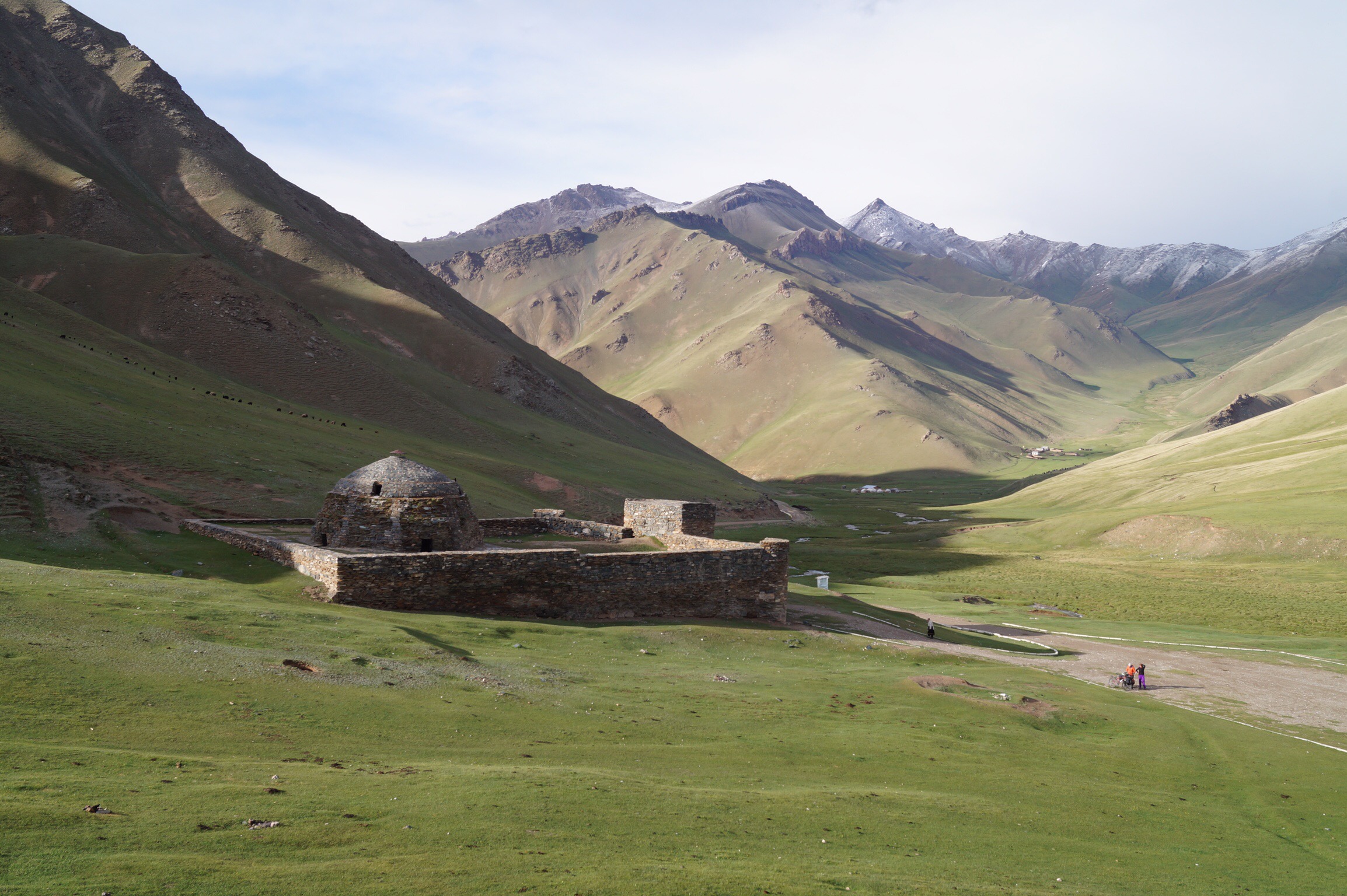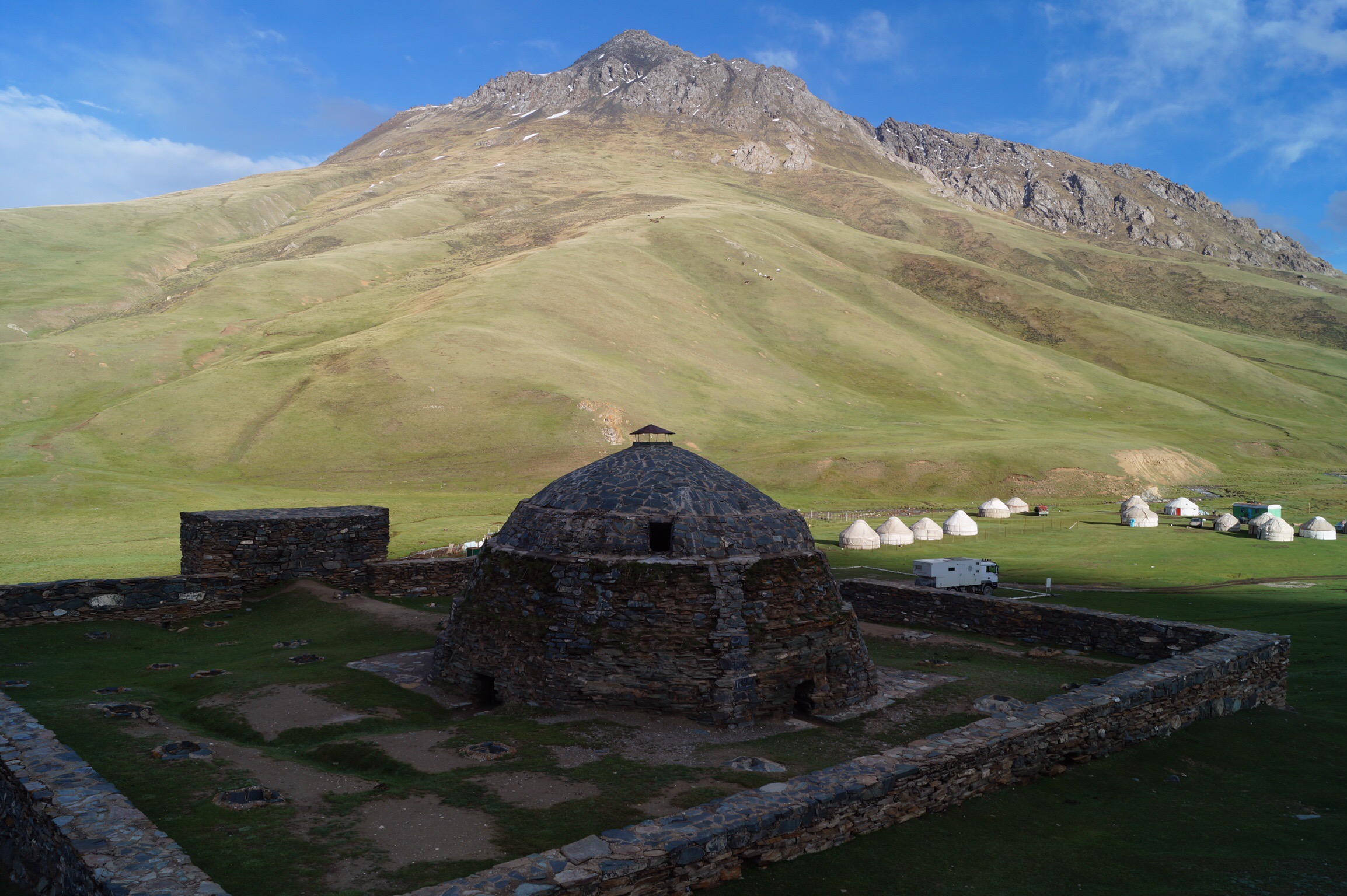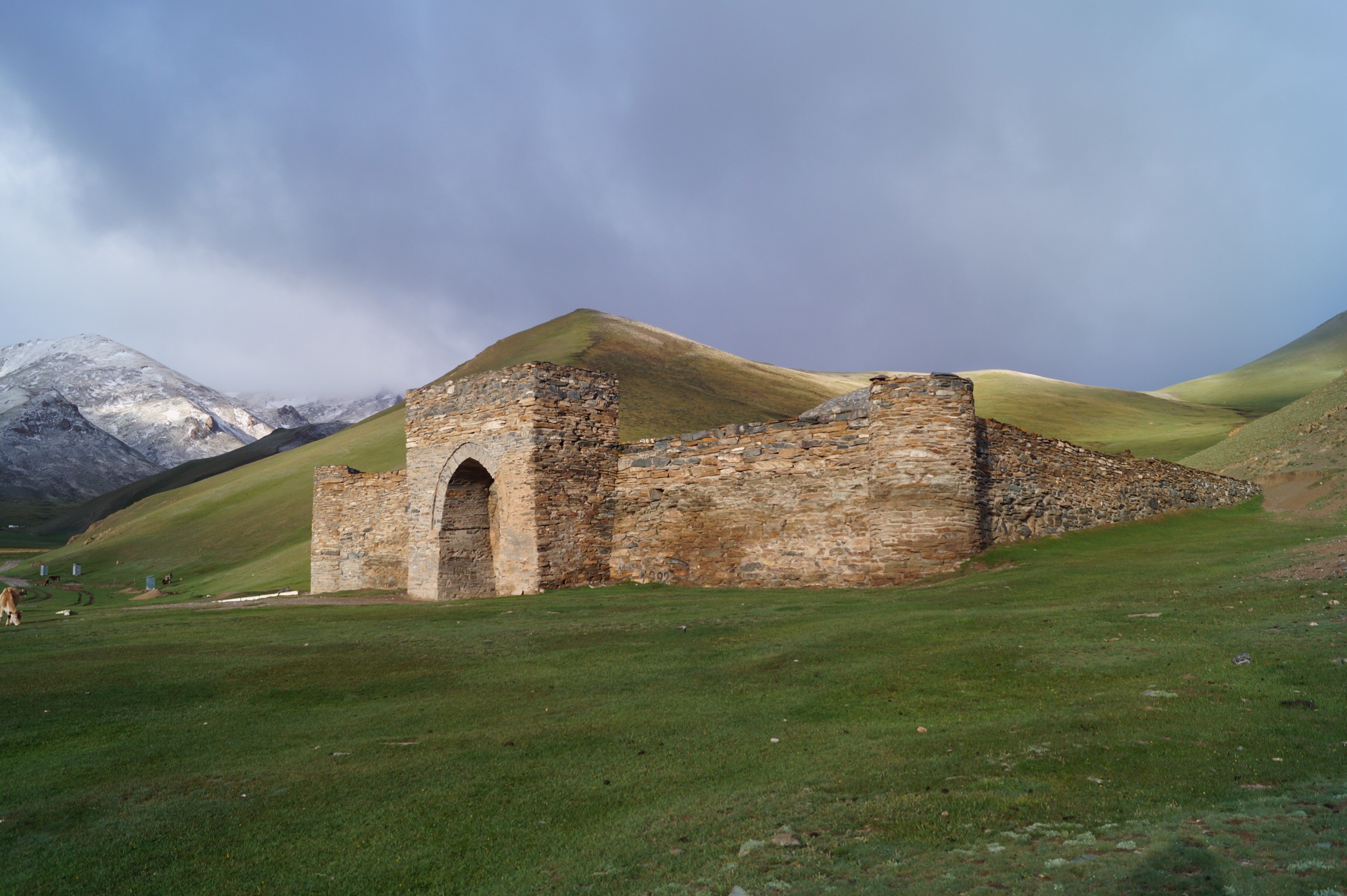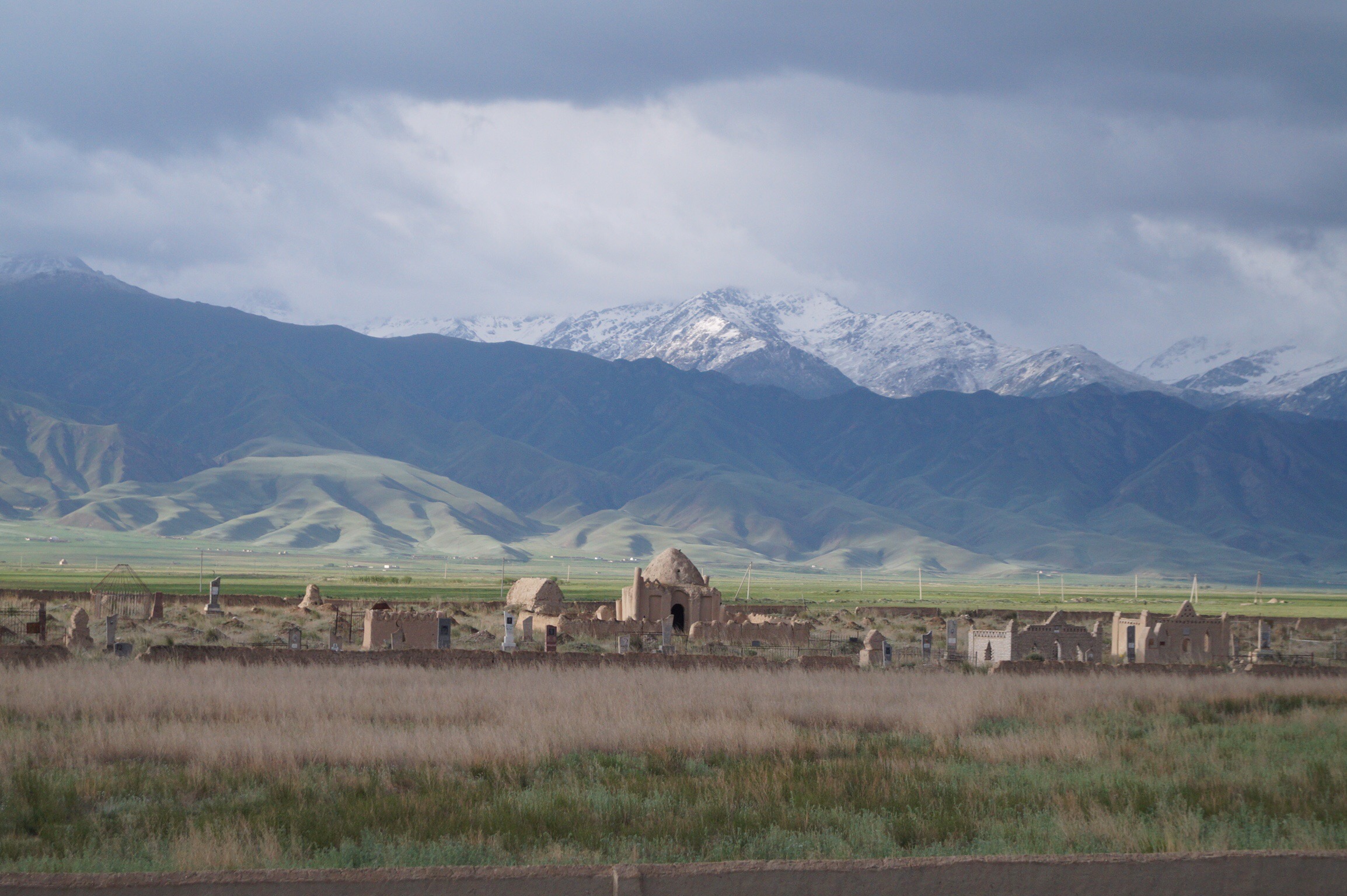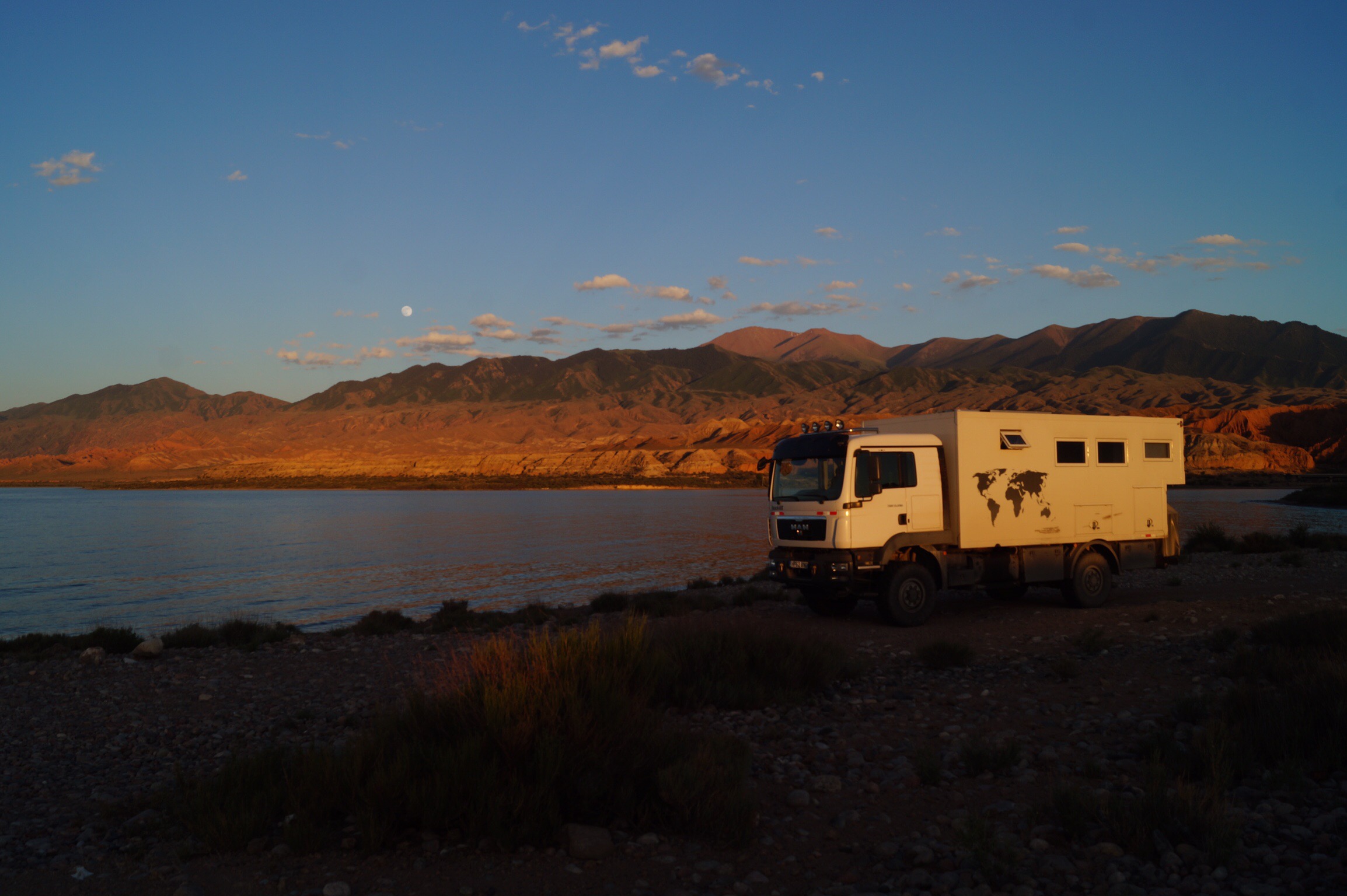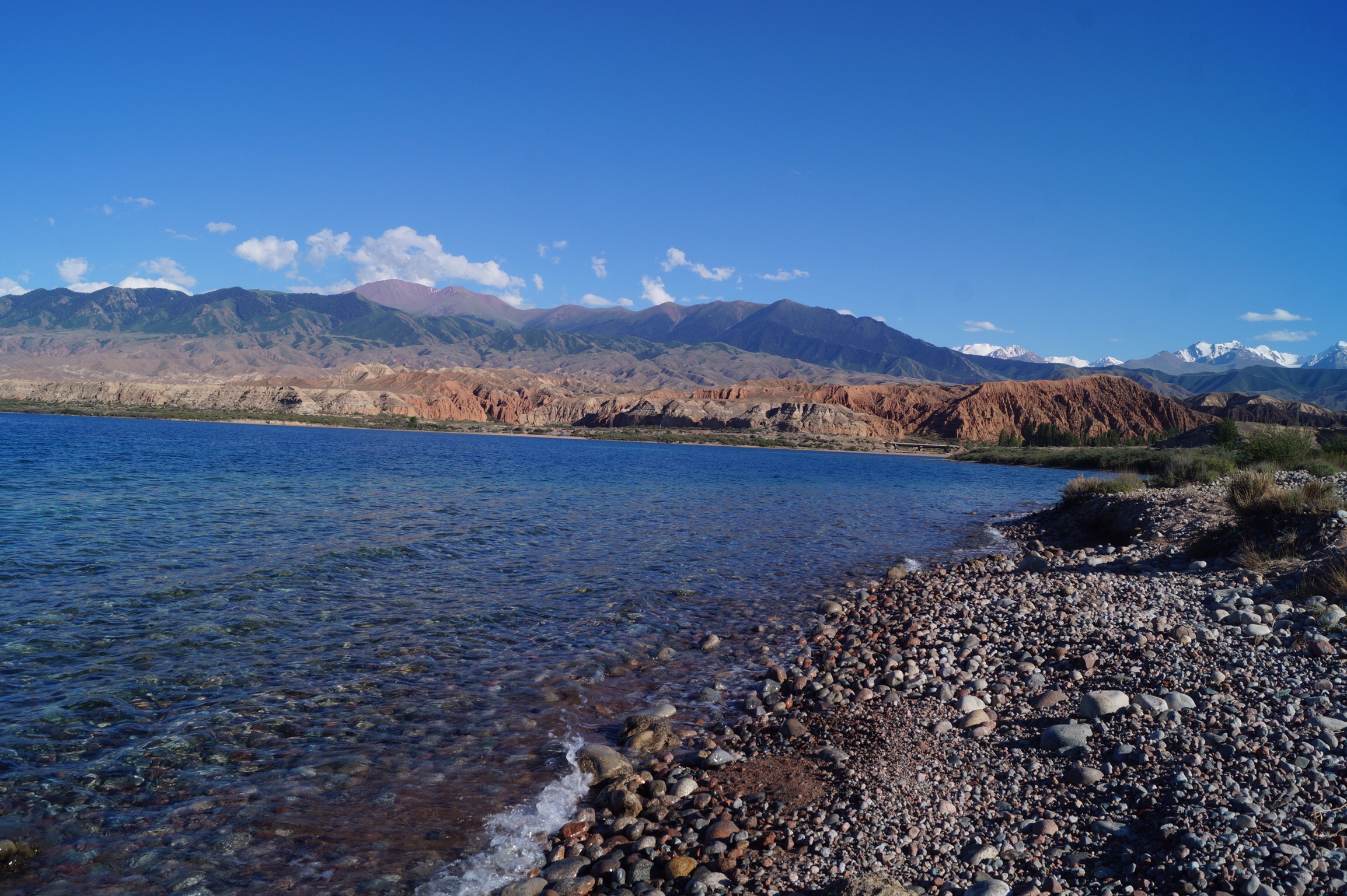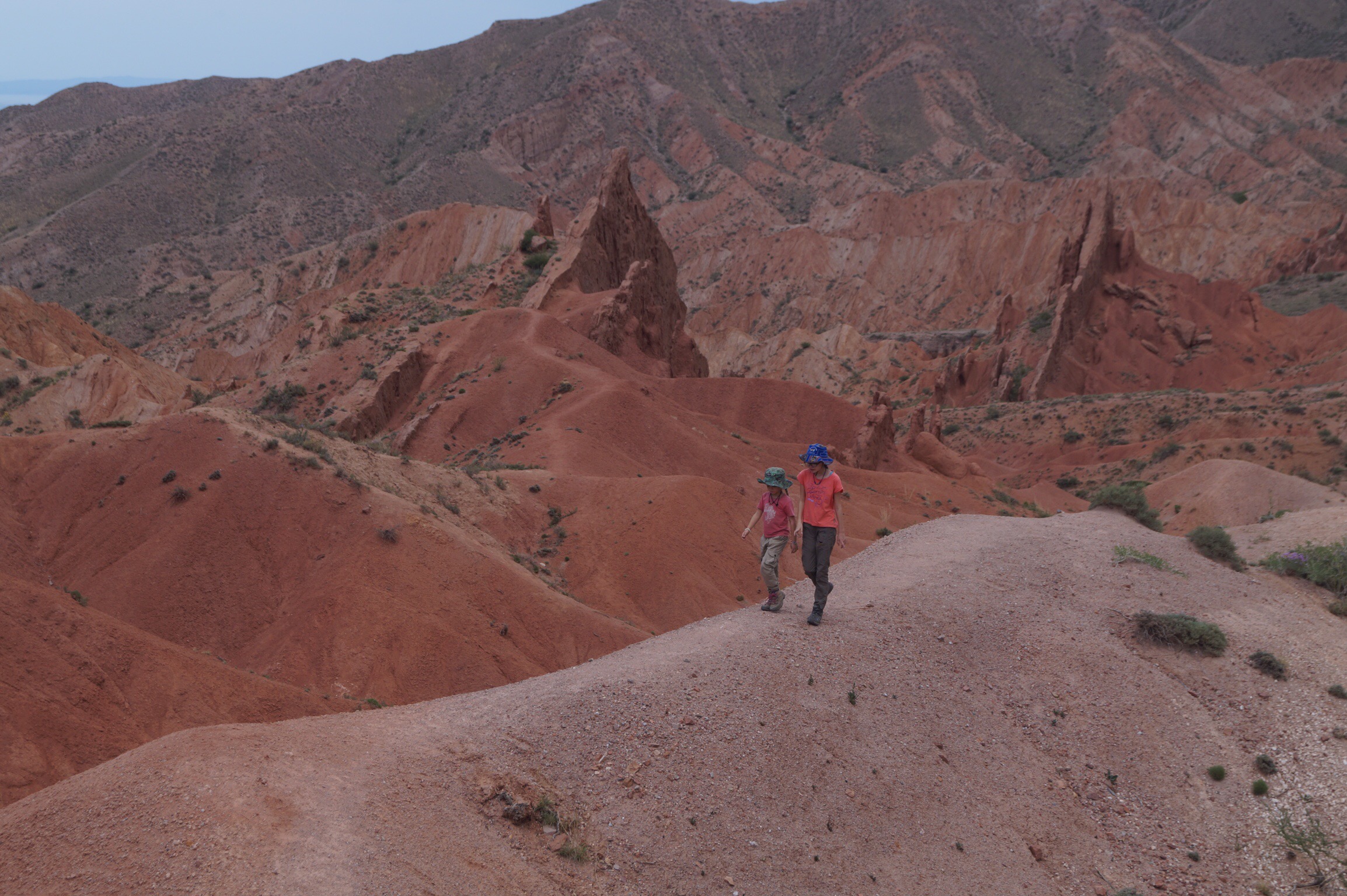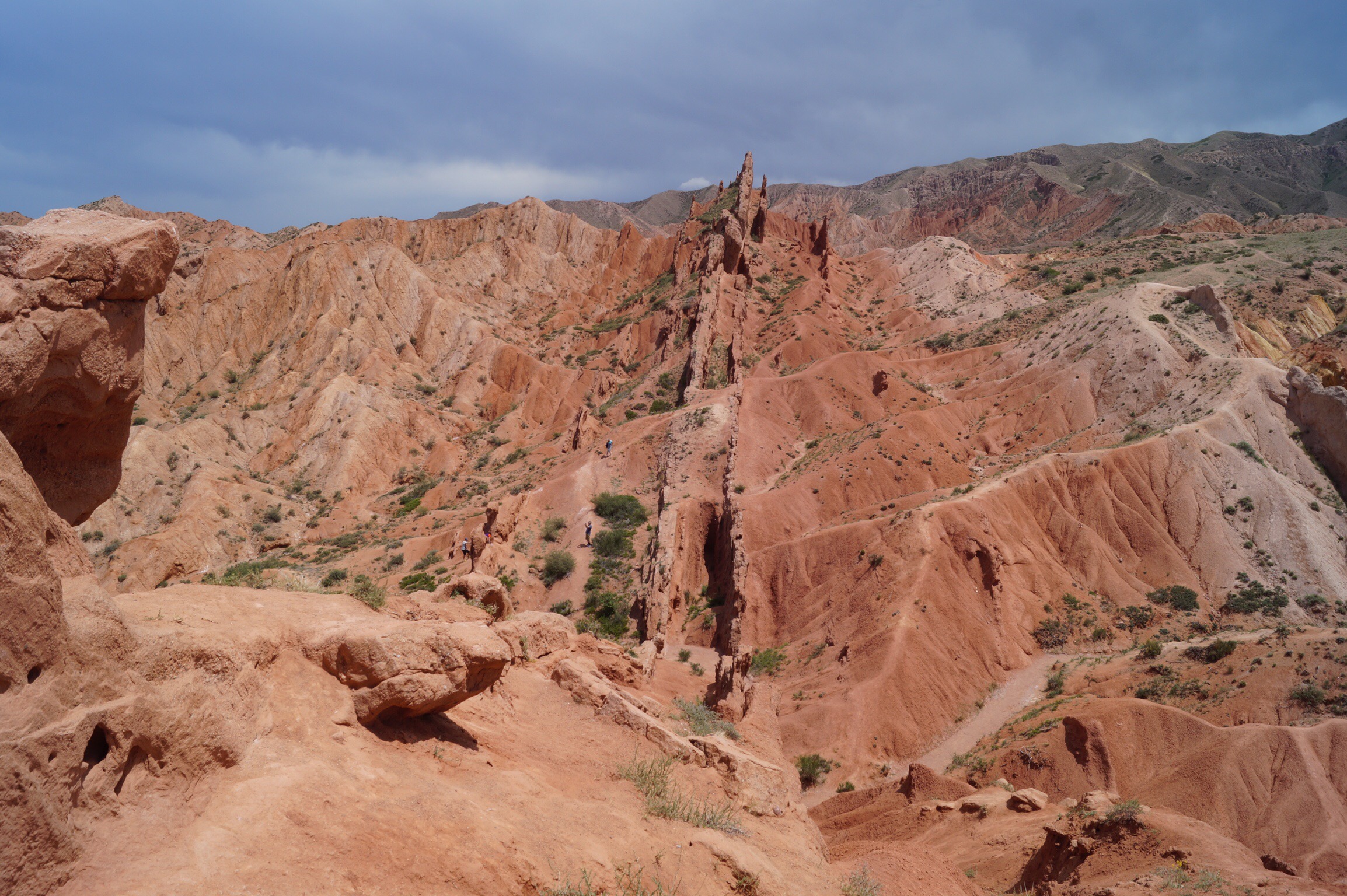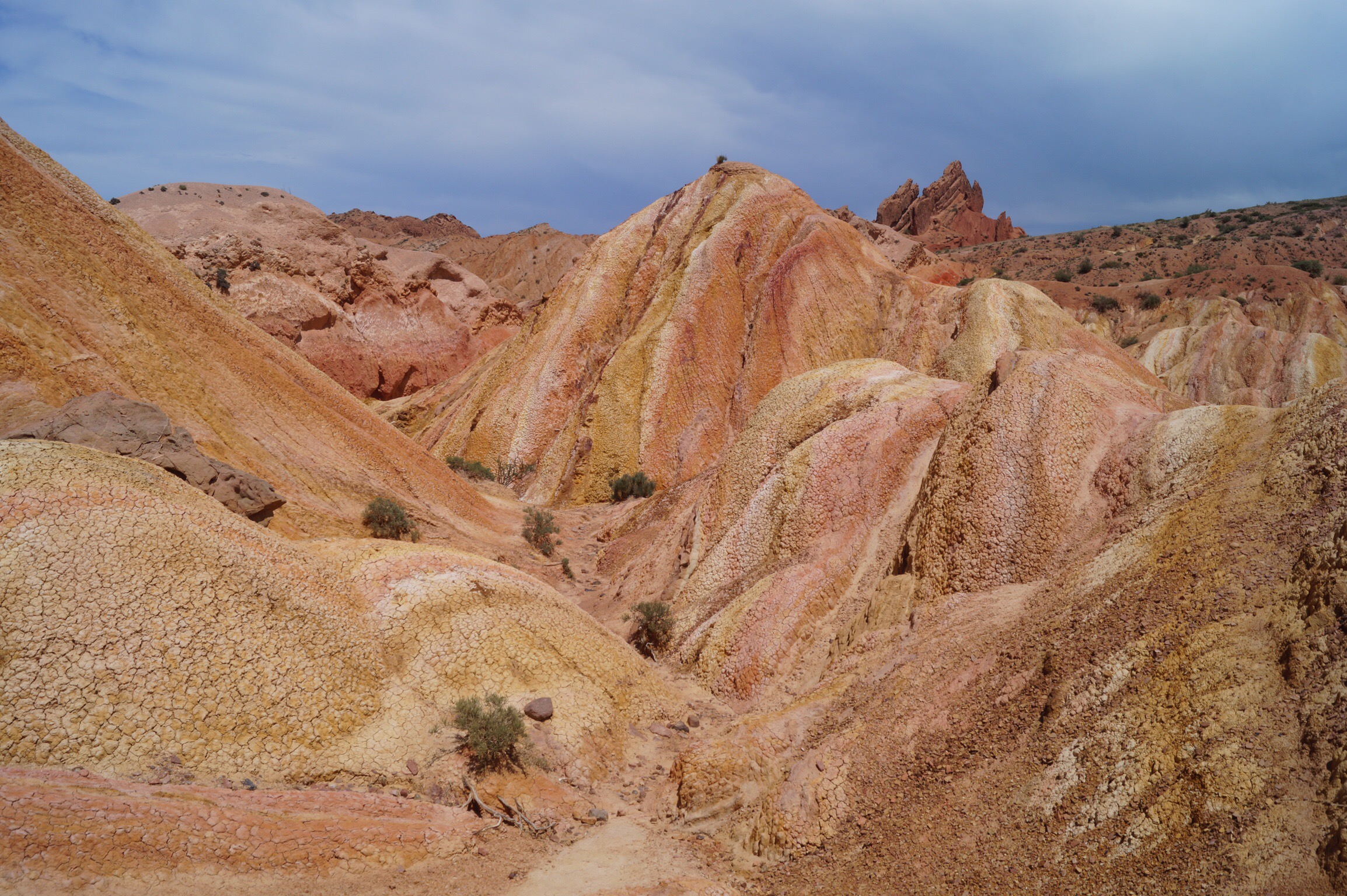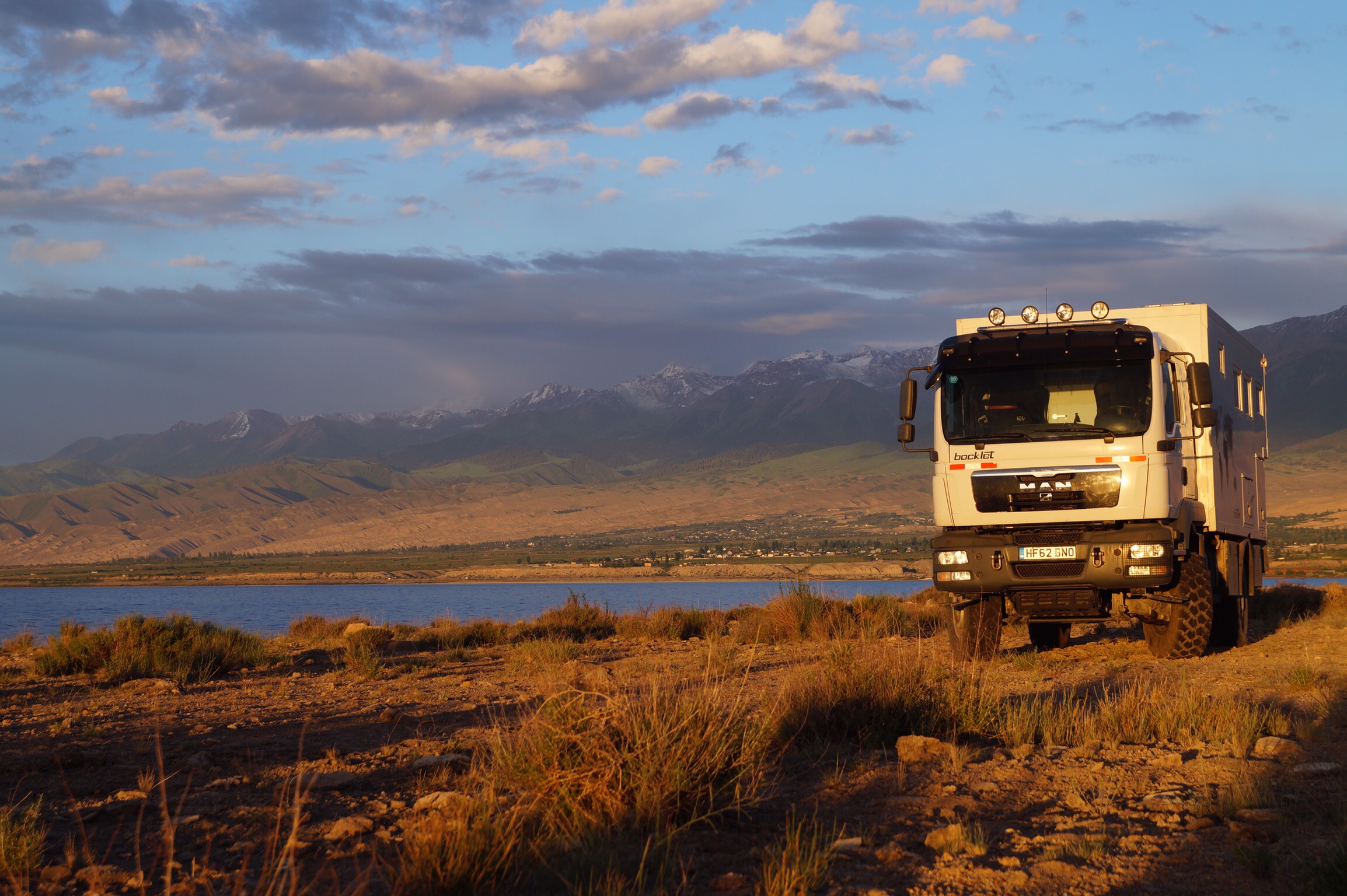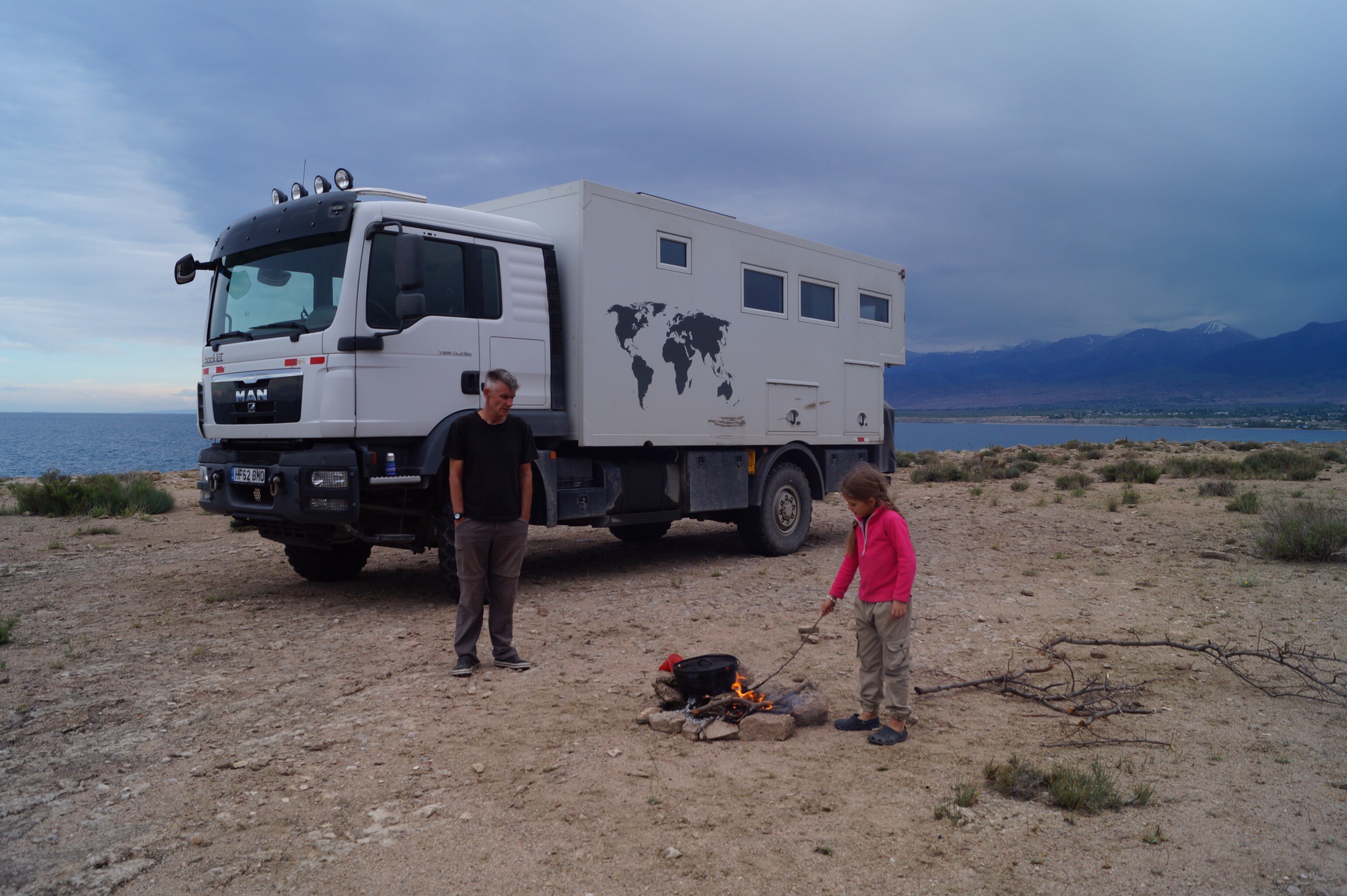This past week we have been literally "a stone's throw" from Afghanistan, to prove it we stopped the truck and tried it out at the river which represented the border between Tajikistan and Afghanistan. Steve got his stone onto the opposite riverbank but the rest of us didn't manage so far. We were just across the Pamir River, running into the Panj River, in Tajikistan. The Wakan Corridor is a narrow strip of Afganistan that was designed to separate British India from Imperial Russia during the "Great Game" era. The road continued along the starkly beautiful valley for another 640km with Afghanistan just across the raging river torrent.
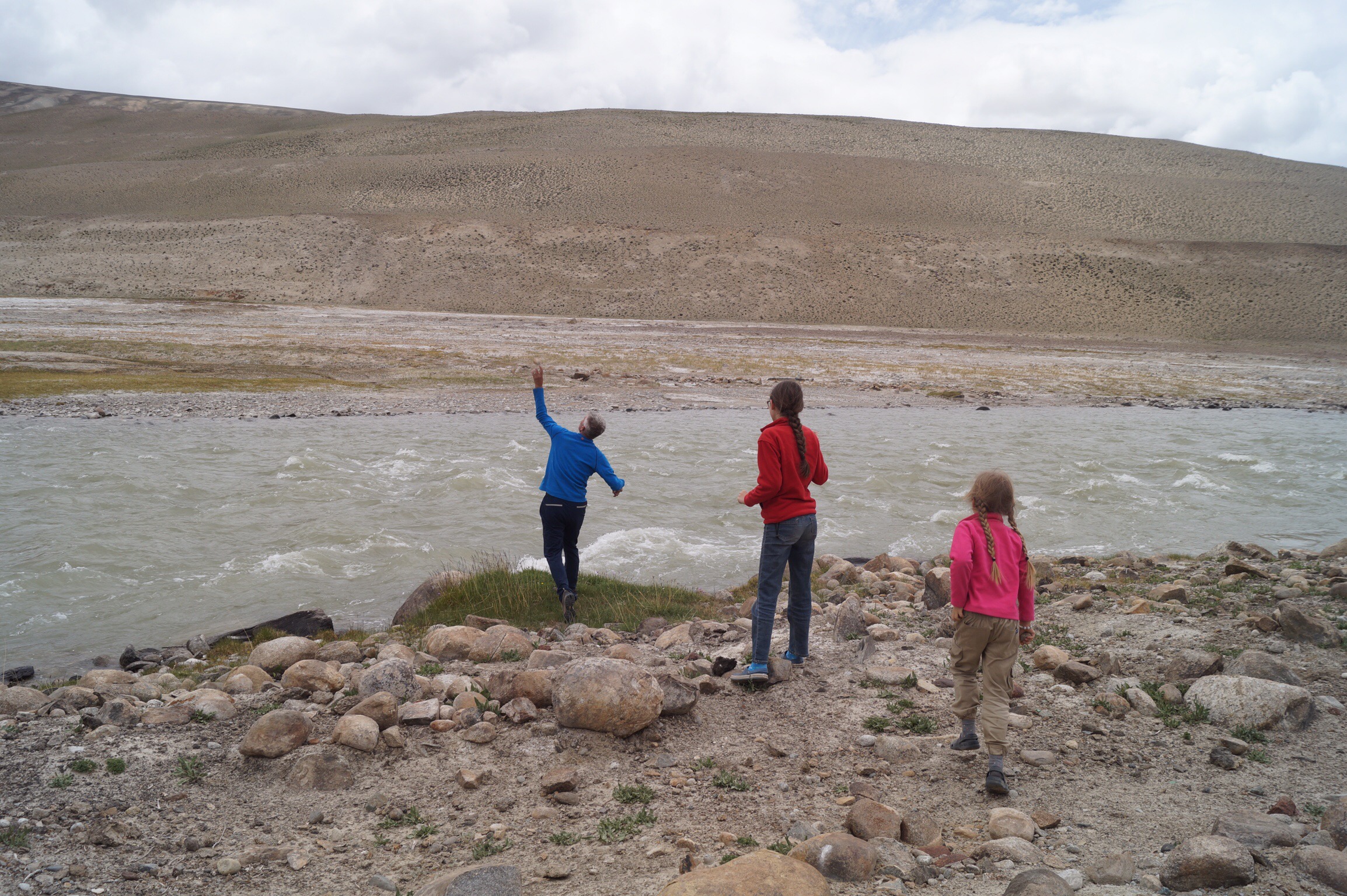
We left Kyrgyzstan earlier in the week at what must be one of the most remote border crossings we have done for a while. The road started off bad and got far worse as we crossed the Kyzyl-Art Pass between the countries. Washed out bridges, mud slides and huge potholes were hard to concentrate on as our eyes were constantly drawn upwards to the lofty peaks still shrouded in snow in the height of summer. We said goodbye to our last mountain sheep statue on a plinth, a frequent roadside attraction in Kyrgyzstan, and gingerly made our way down the other side. With so few people using the border the Tajik soldiers had to be roused from their beds to process the many documents we needed to get into the country. The contrast couldn't have more different, while the Kyrgyz side was green, it felt like we had transited to the moon with the stark lunar landscape on the Tajik side.


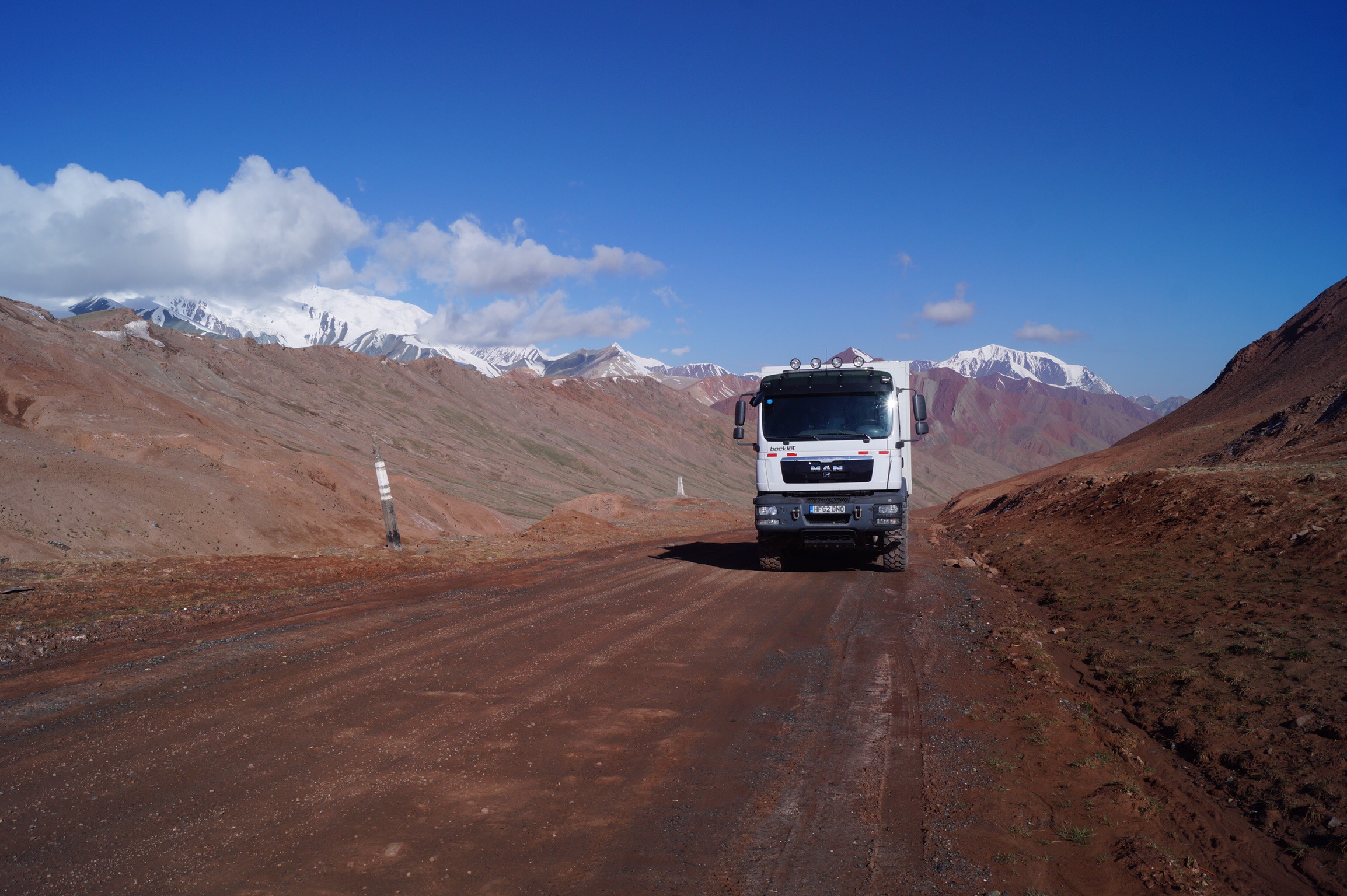
In a panorama with so few people it wasn't hard to find a spot to camp in, however an hour or so after we had set up camp an almost impossible-to-break, soviet built, small UAZ truck approached us. They wanted to cross the river, swollen with melt water, to go to their summer camp but were concerned about getting stuck. Could we pull them out them out if it all went wrong? We were pleased to get back to our chicken stew on the fire, when they made it though. We were even more pleased for them, when washing up, to see them crossing back safely over heavily laden with yak dung patties for fuel waving triumphantly.
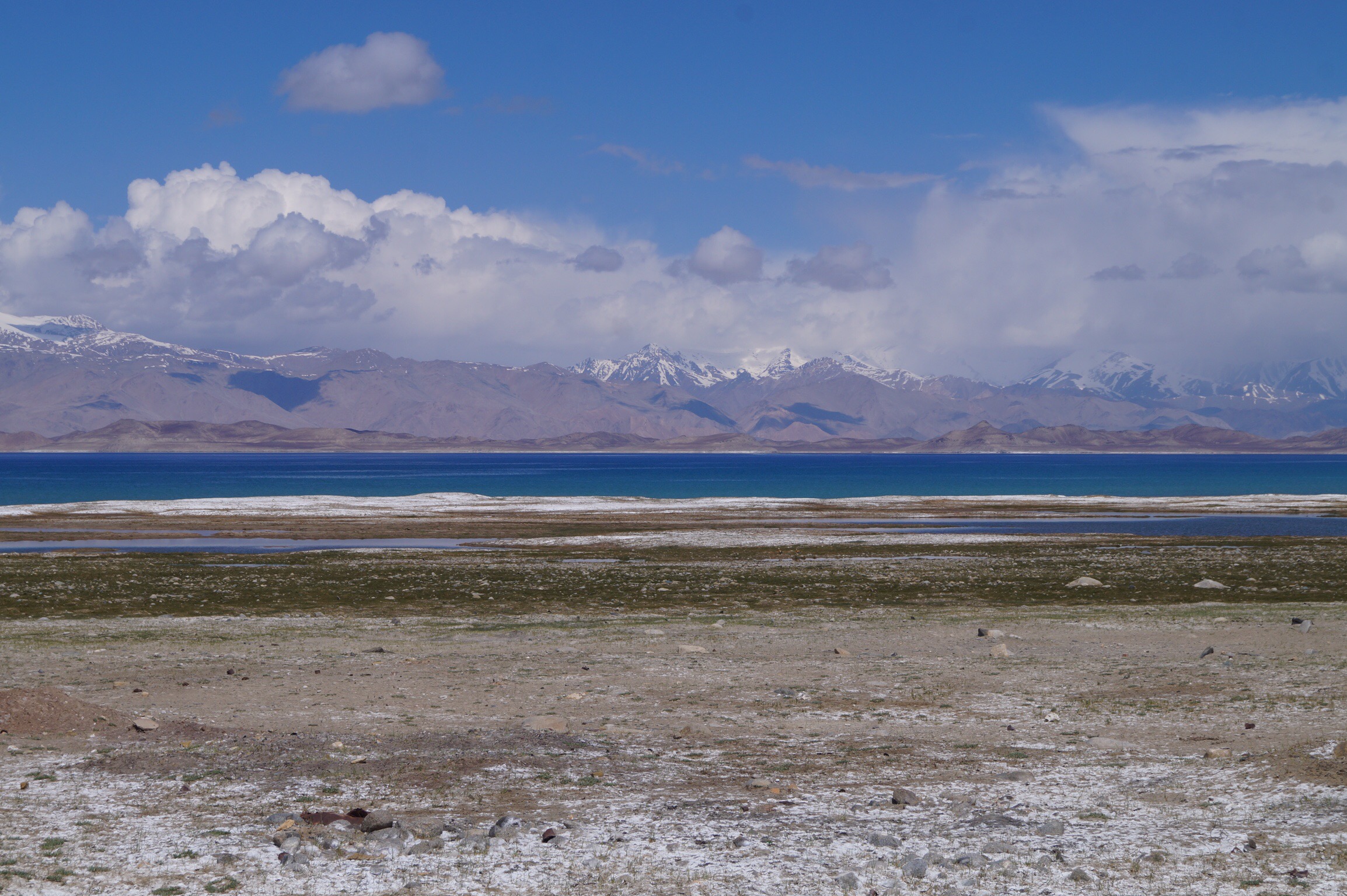


T
he bazaar at Murghab was entirely constructed of old shipping containers, a motley collection in the middle of nowhere but filled with friendly souls many wearing the traditional Kygryz felt hats. The scenery as we drove through the valleys of the Pamir Mountains was otherworldly with screes slopes of every colour of the rainbow, I hadn't even know that you could get purple rocks. Above these were the constant presence of high peaks cloaked in white. That night we took a detour a few kilometres off the road to sleep the night beside Lake Bulunkul. When we awoke in the morning, Steve and I snuck out while the girls slept on to climb the nearby hill and admire the still, mirror-like lake reflecting the surrounding mountains.


Although the main road continued through Pamirs, we wanted to take a side route across the Kargush Pass towards the Tajik border overlooking the Wakan Corridor of Afganistan. It was a dramatic drive with just the odd marmot as company. We were hoping our special permit was valid at the rough two man army checkpoint on the other side, there had been some confusion at an earlier checkpoint with our half-forgotten Russian about whether we would be allowed onwards, we didn't fancy the drive back over the pass. We were allowed to continue on the single lane dirt road which was often cut out of the sheer cliffs walls of the valley. Between the army post and the first village of Langar, there was a 70km section that was completely uninhabited.
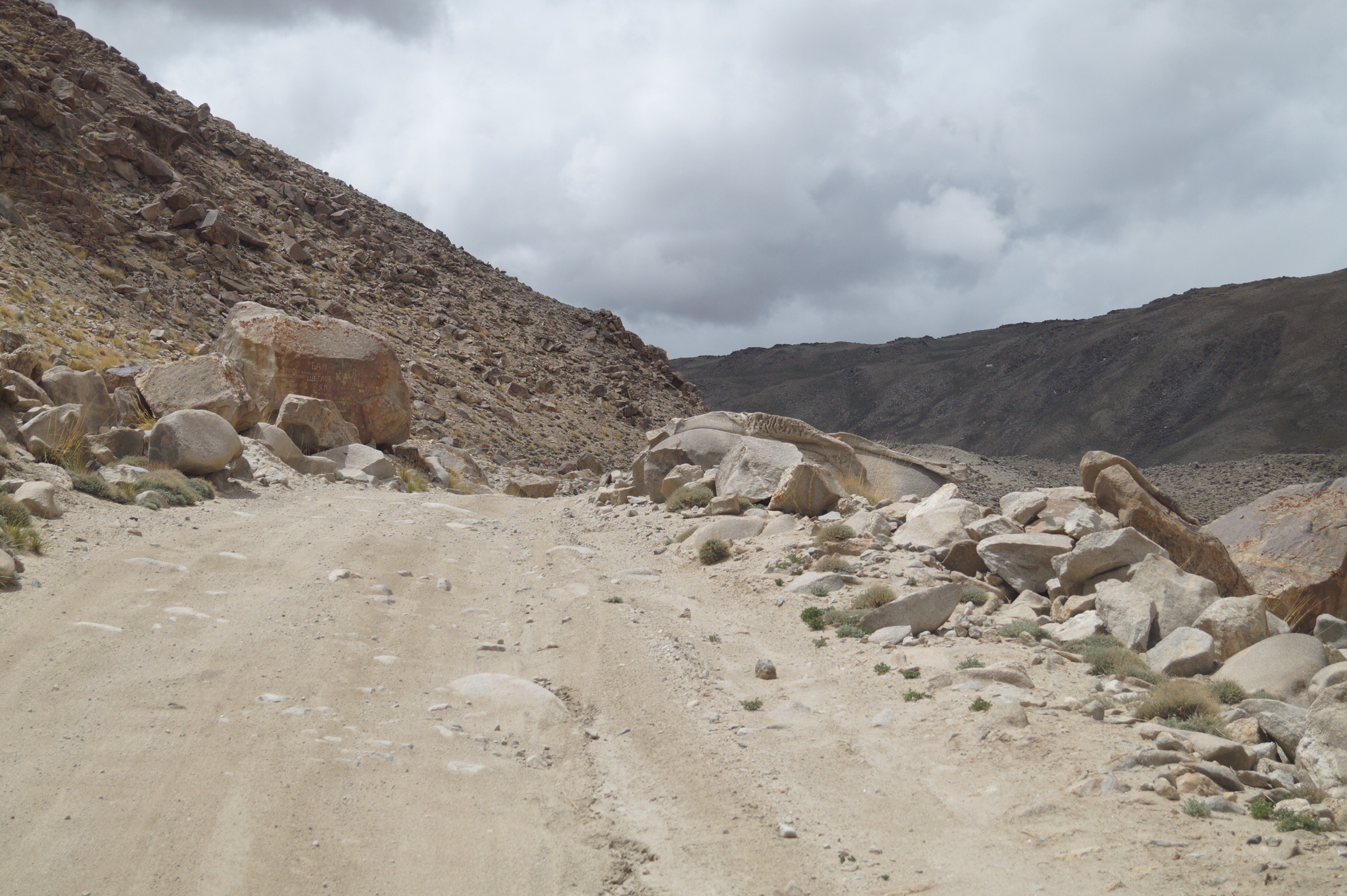

You know you have found a good camp spot when you stop for lunch somewhere and decide to spend the night. With no wind and bathed in sunshine, it was warm enough to sit outside and admire the stark walls of the canyon changing colour as the light shifted. Pulled off on an old section of the road, far above the rushing waters, we saw one other vehicle that whole afternoon. In the mountains the weather is always changeable and after a couple of hours we were snuggled inside listening to the wind howling.
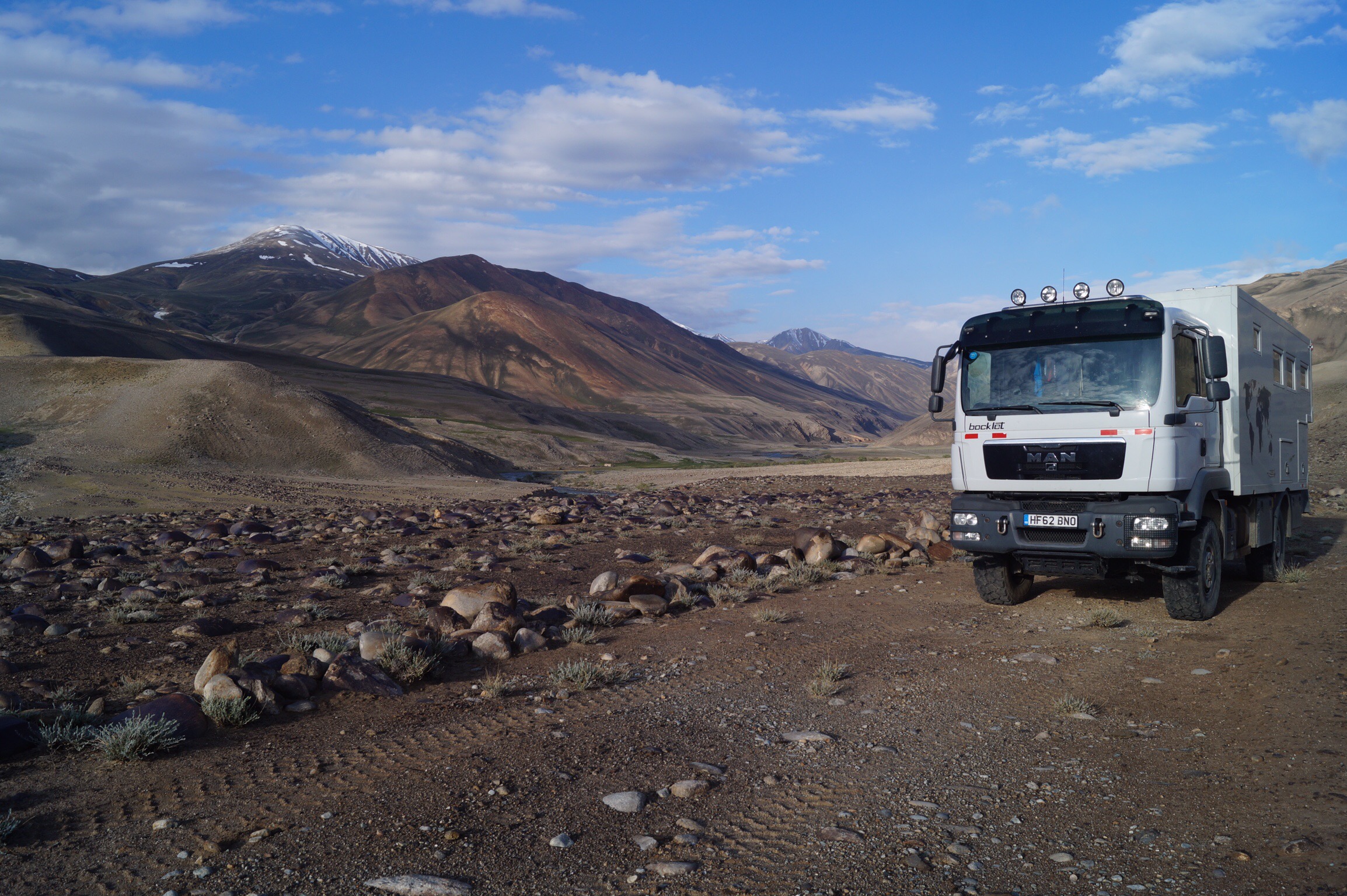
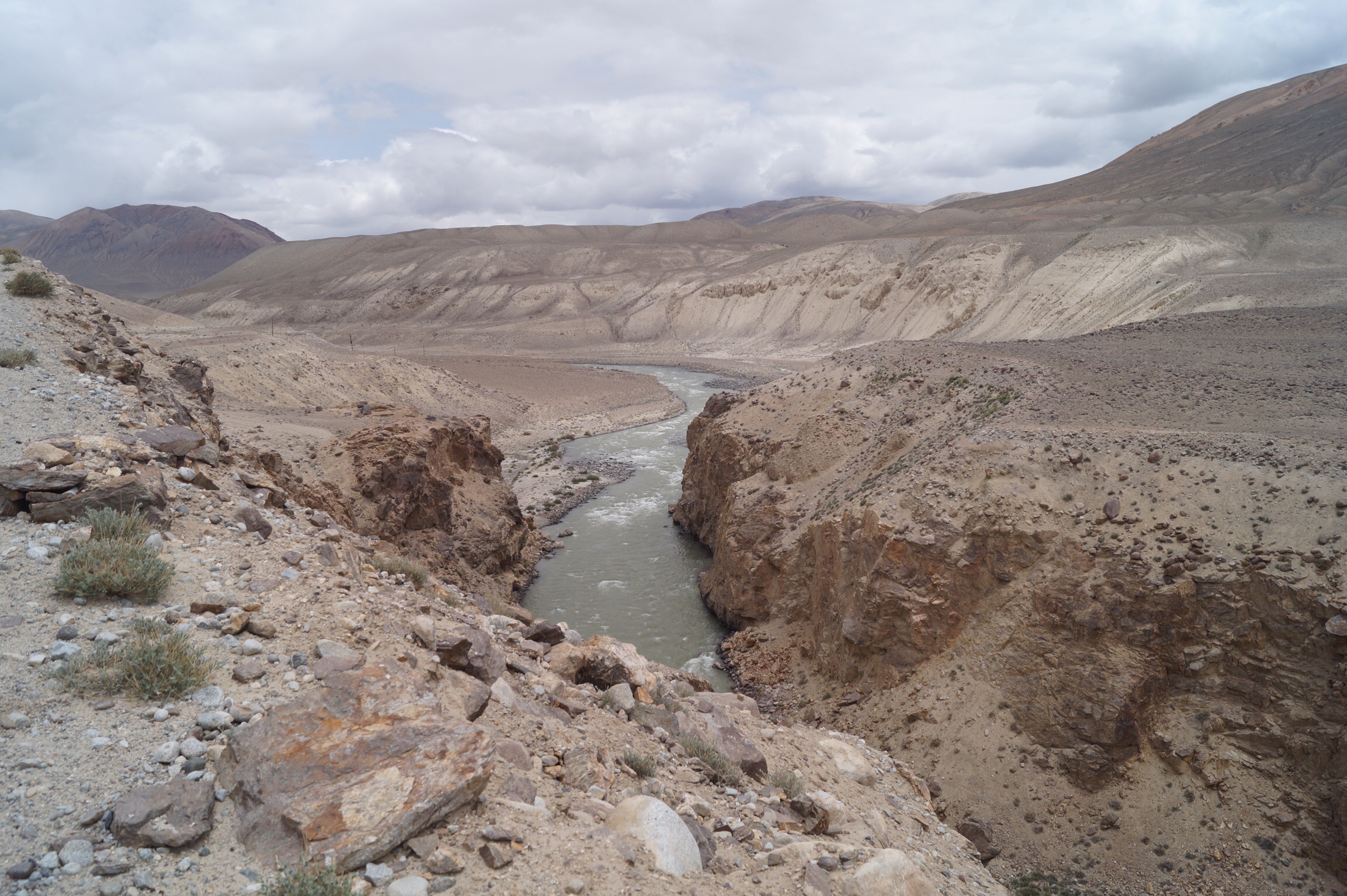
The glimpses we got of Afghanistan, so tantalisingly close, were fascinating. Like the Tajik side, the villages were limited to patches of green clinging perilously to the impossible steep mountainsides. We'd been delighted to learn from the Kygyz herders we met that they use the word "caravan" for a group travelling together. Now here on the Afghan side we saw a caravan, just as how you would imagine it from the Silk Road days, with camels and horses laden with goods packing up at mud brick house. The road was pretty bad on the Tajik side, damaged by spring floods and geological activity, but at least it was continuous. On the Afghani side between a few small hamlets it was still being built, a few men chipping away at the sheer rock face with basic picks, and I assume some dynamite, but thankfully not when we were driving past. Compared with the mental image you get when you think of Afghanistan, it looked very serene and arcadian.
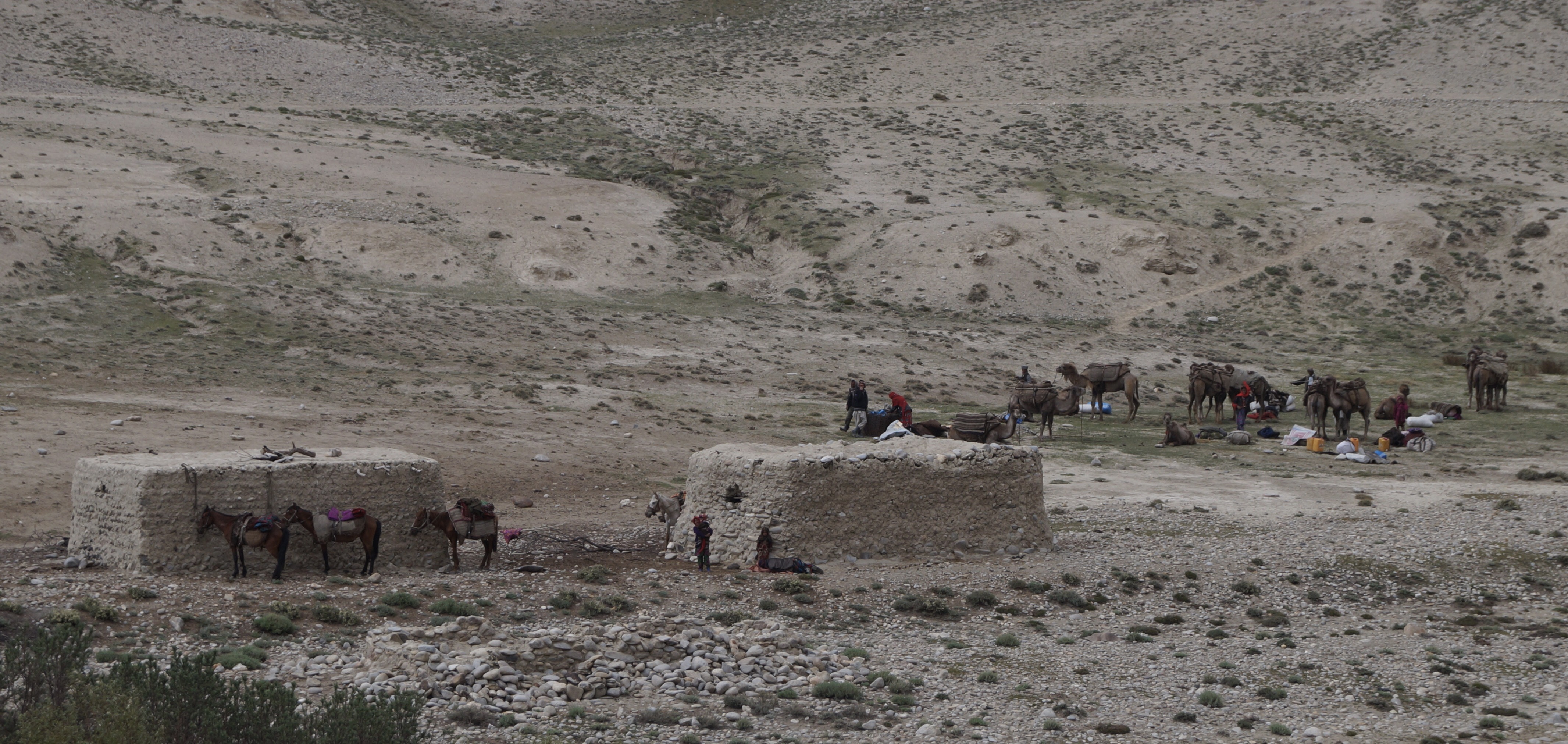
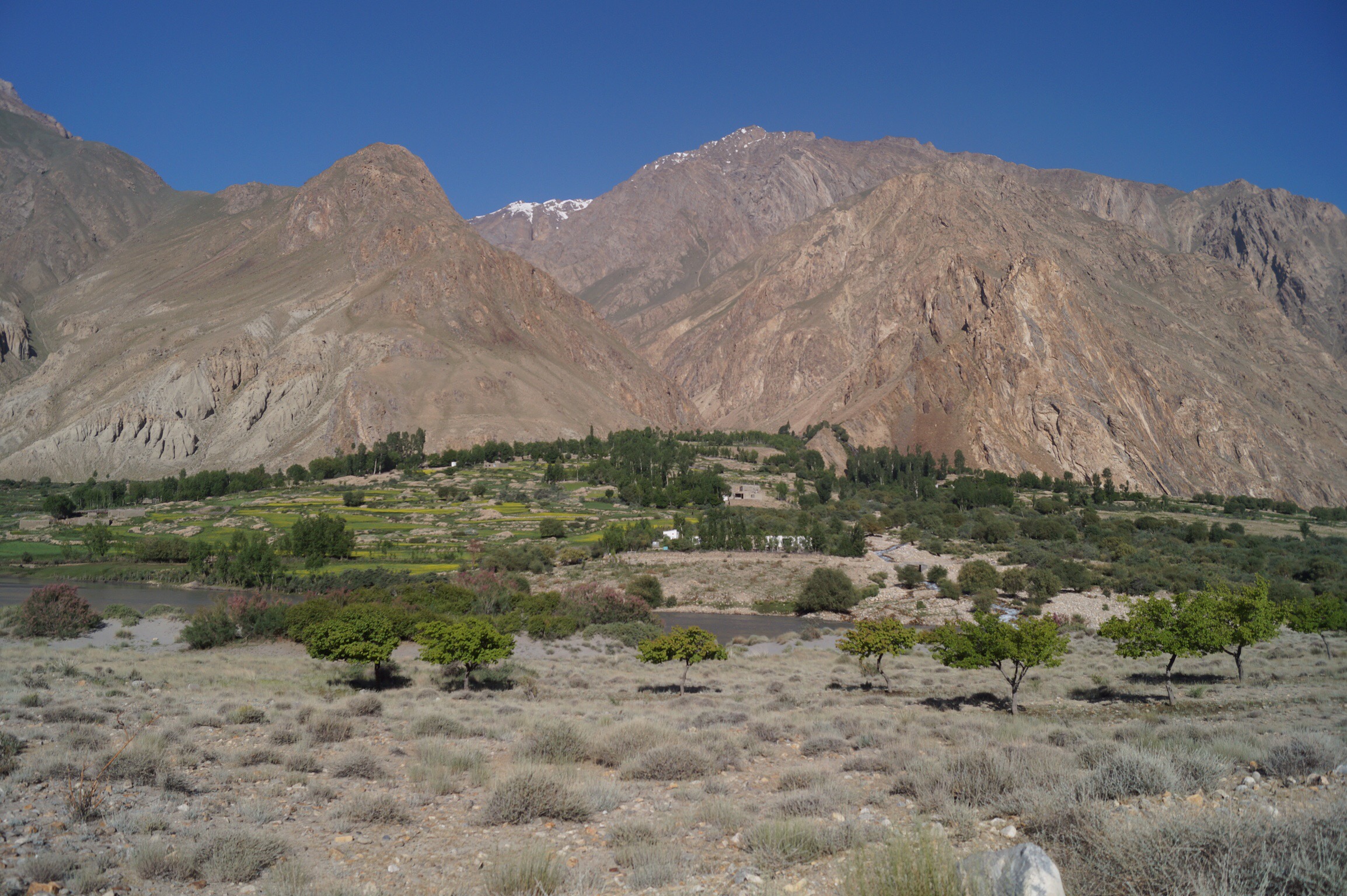
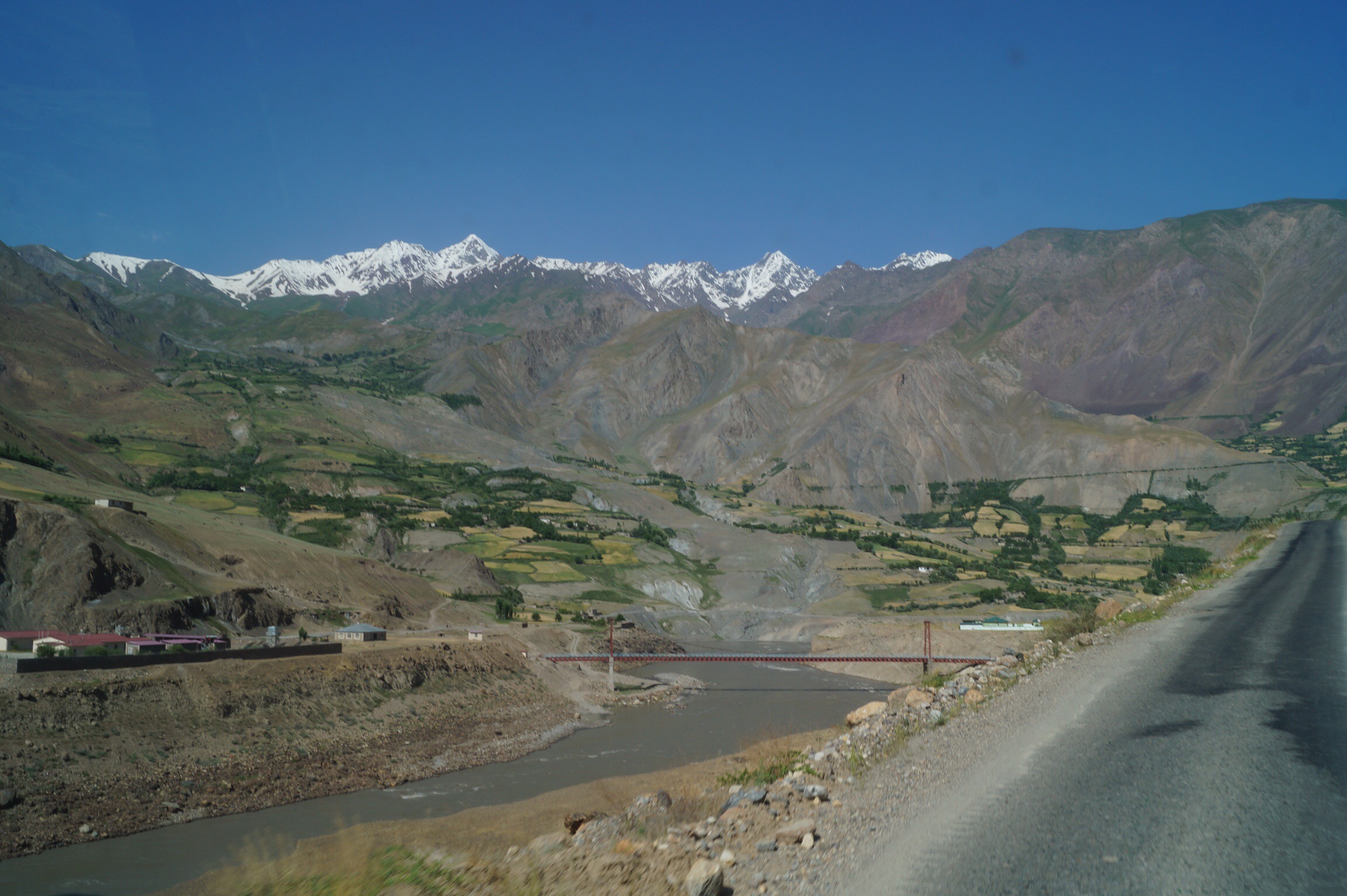
Where's the next bit of road!?!

The rest of the week was spent slowly, and very bumpily, making our way along the 640km of the Pamir Valley. To the left of us, the river gradually swelling from a grey gushing stream to a scary looking muddy brown torrent. As normal as it is for this time of year, as more meltwaters join from the mountains every kilometre. It must have been pretty high this year as the swirling waters crashed against the sides of the canyon, flooding the banks and we saw it had even washed away some of the road on the Afghan side.
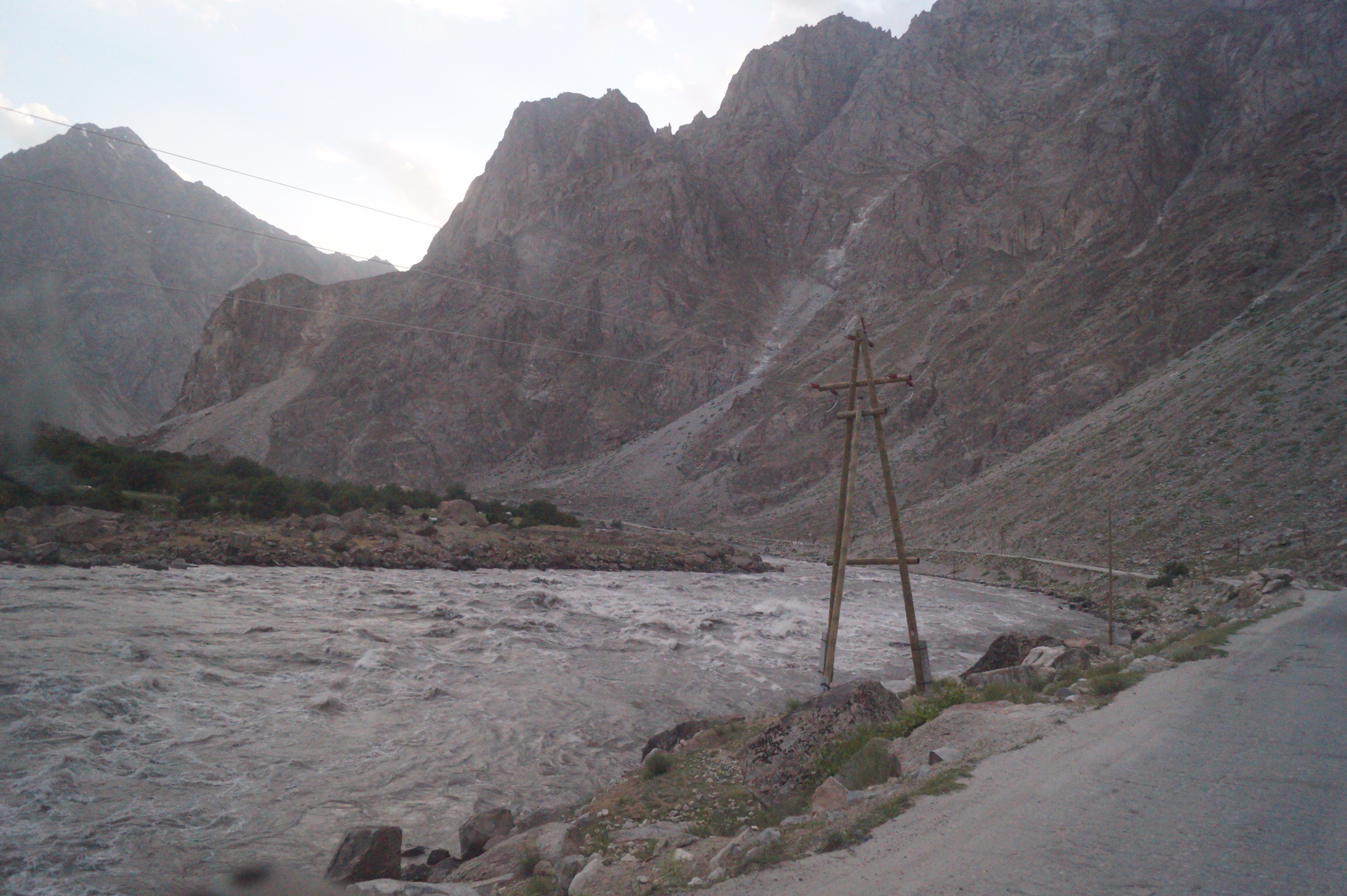
One of our favourite spots was in the widest part of the valley, where the river had spread out and slowed to a less alarming flow. We found a spot on the riverbank way off the road, surrounded by purple flowering bushes and a partially separated branch of the river that had warmed in the sun. Time for a family hair wash and a whole body dip for the bravest of us all (Lucy). Our hot water heater tank broke way back in Thailand and these last couple of months in the mountains have been painful at times, so we were thankful for the slightly warmer wash.
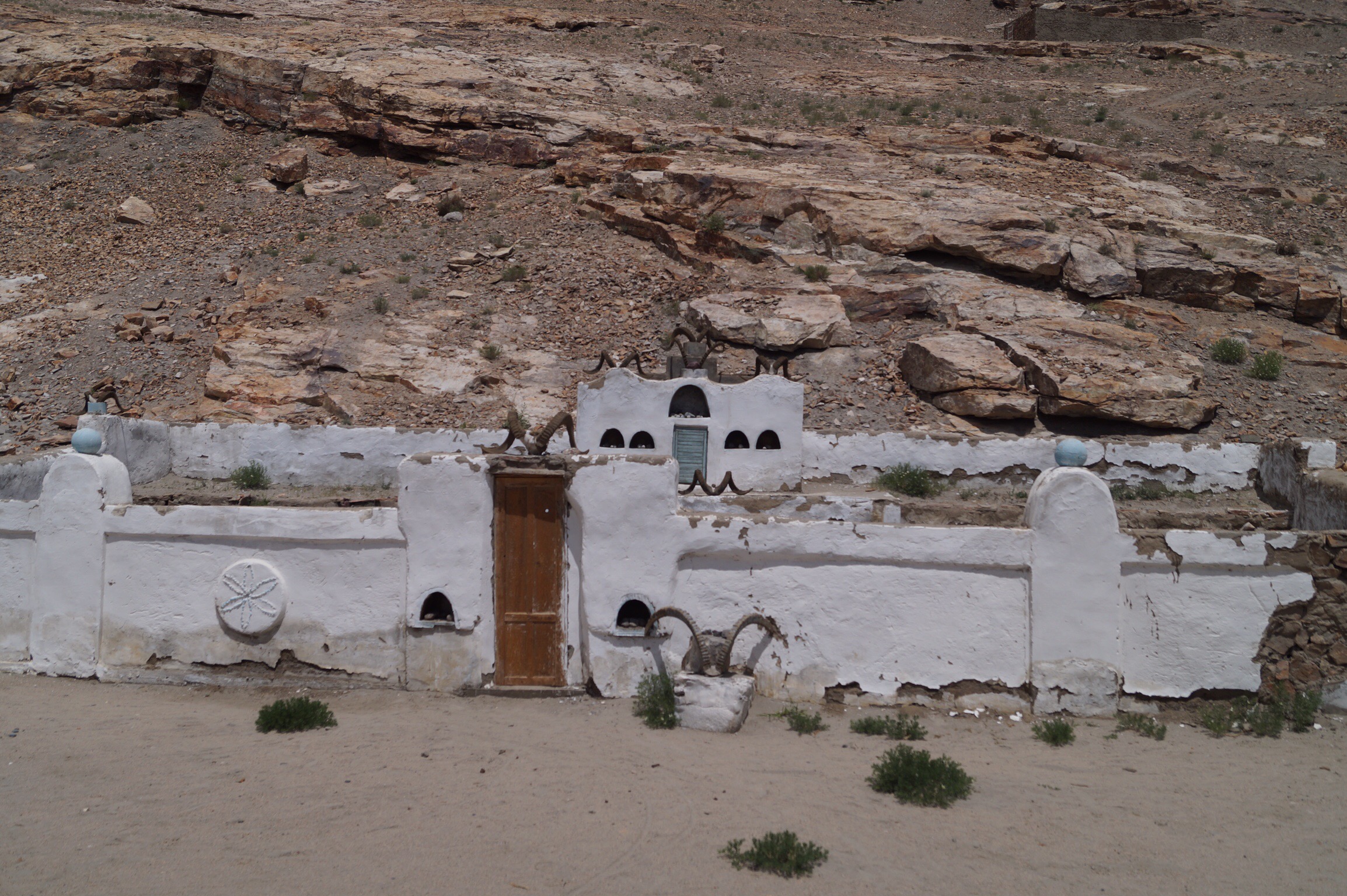
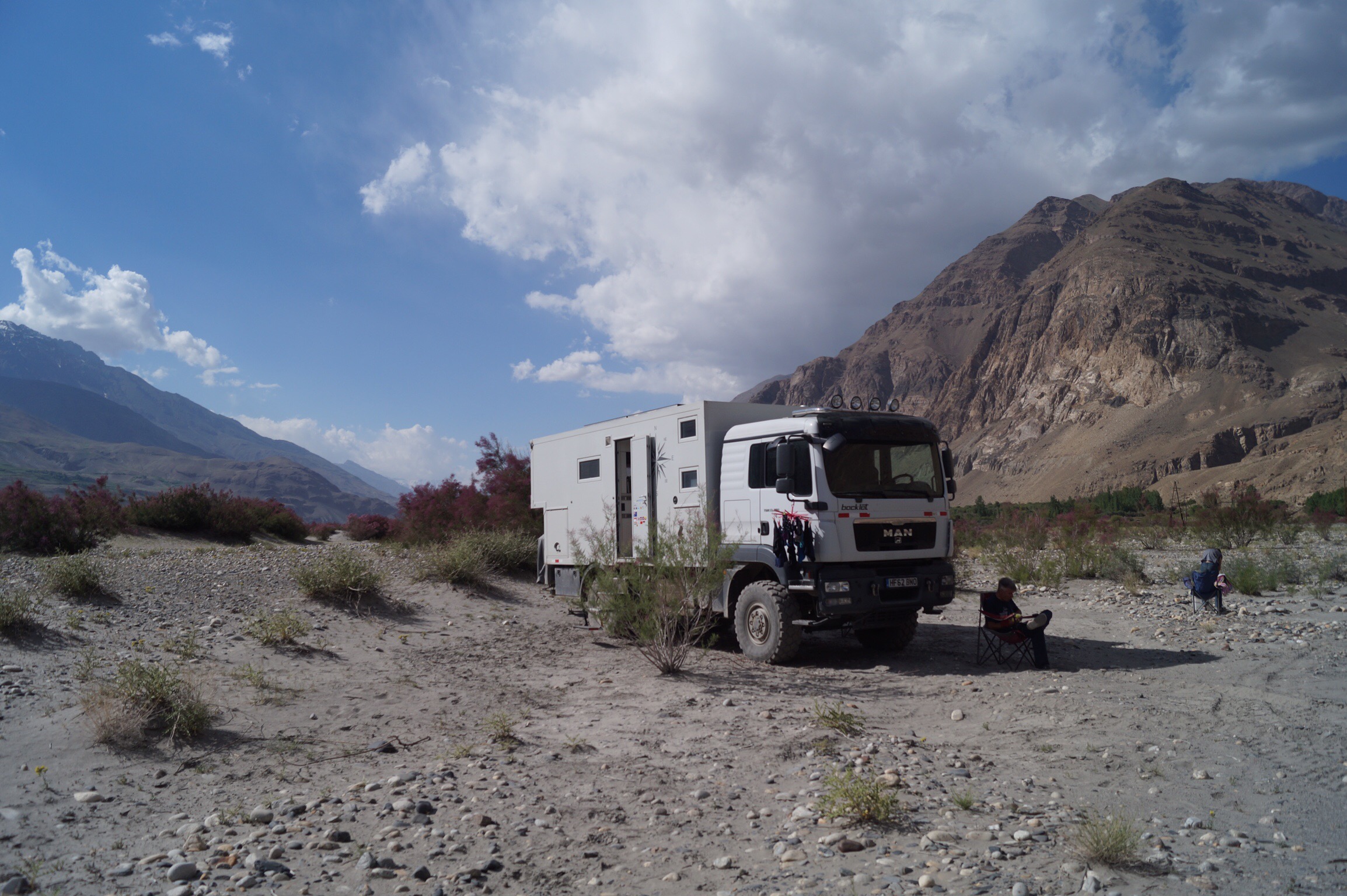
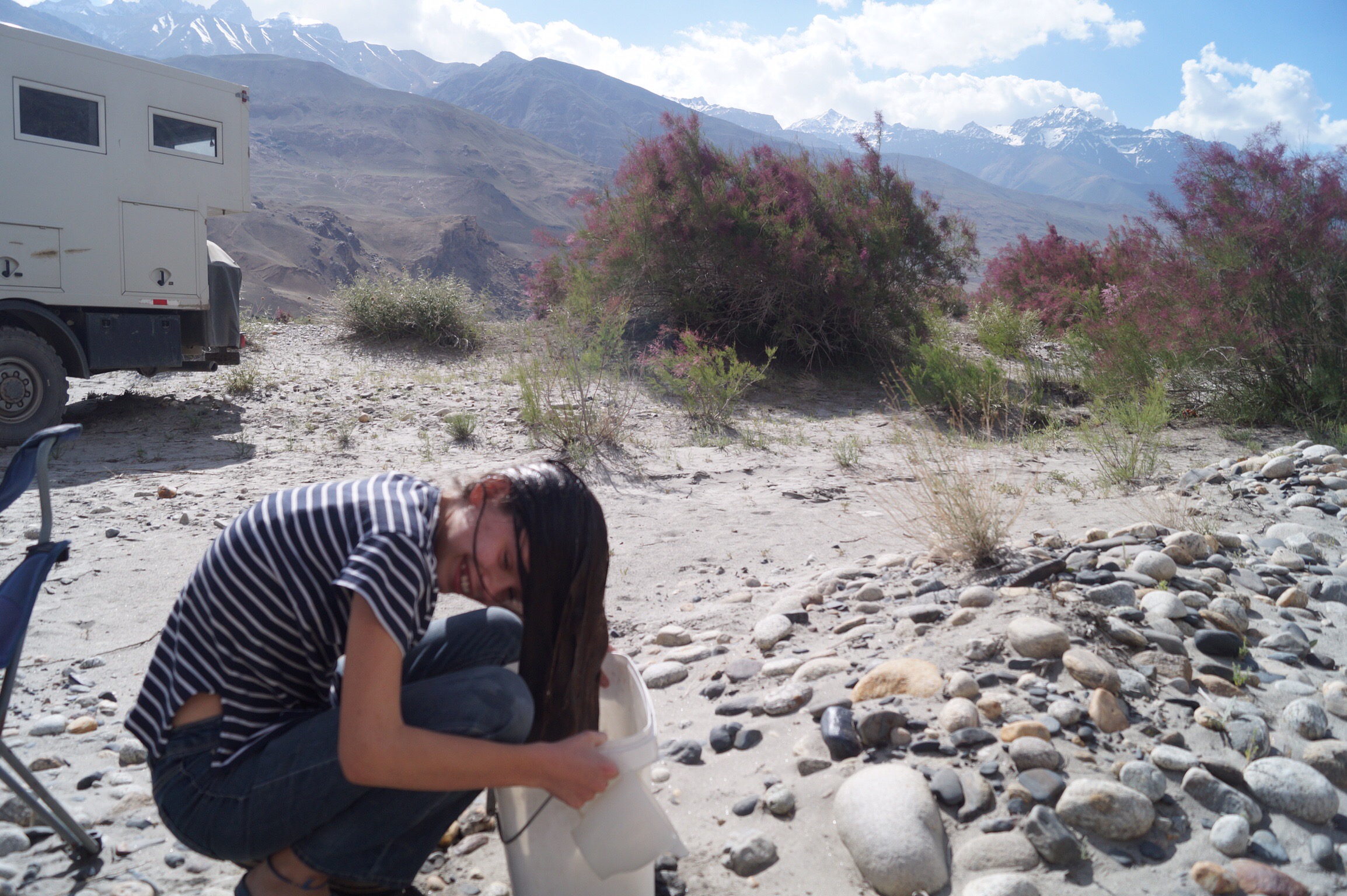
In Khorog, the pleasant main town of the Pamirs Steve went off to find a welder for our disc-brake covers, a reoccurring problem every 10,000 km. Asking some workmen demolishing a house, they took him to another building site and welded the 2 covers. They refused any payment at all, even money for cigarettes, with a "Welcome to Khorog. " The next day Steve replayed the karma by helping a couple of local guys who were subjecting their poor tiny Chevrolet Spark to hundreds of kilometres of roads that were challenging for a hardcore 4x4, with only a screwdriver for a repair kit. Unsurprisingly their steering rods had gone awry. On a road like that, I'm not sure they were going to make their final destination without another roadside stop, hopefully someone else nearby will have more than a screwdriver.


Driving up the narrow and steep Bartang Valley to the north, hoping to do a short trek, I lost my nerve and made Steve turn round when we were already 16 km in. The river took up the whole width of the valley, flooding any possible place where we might camp, and was lapping the edge of the low track. The fast flowing torrent wouldn't look out of place in a disaster movie, especially in such a steep-sided, narrow canyon. Only the 3 villages we passed through, tiny pockets of green in the brown bare valley, seemed high enough out of the waters. The villagers were working hard in the short summer, planting and nurturing their crops in every inch of green. However, they didn't seem at all perturbed by the amount of water, smiling and waving as we passed back through. I stuck with my overlanding mantra, "Always go with your instincts." Seeing the floods, we decided that the trek didn't look at all attractive. As it started with a valley crossing in a metal box suspended across the swollen river a bit like cable car, just big enough for 4 - definitely like a start of a disaster movie!
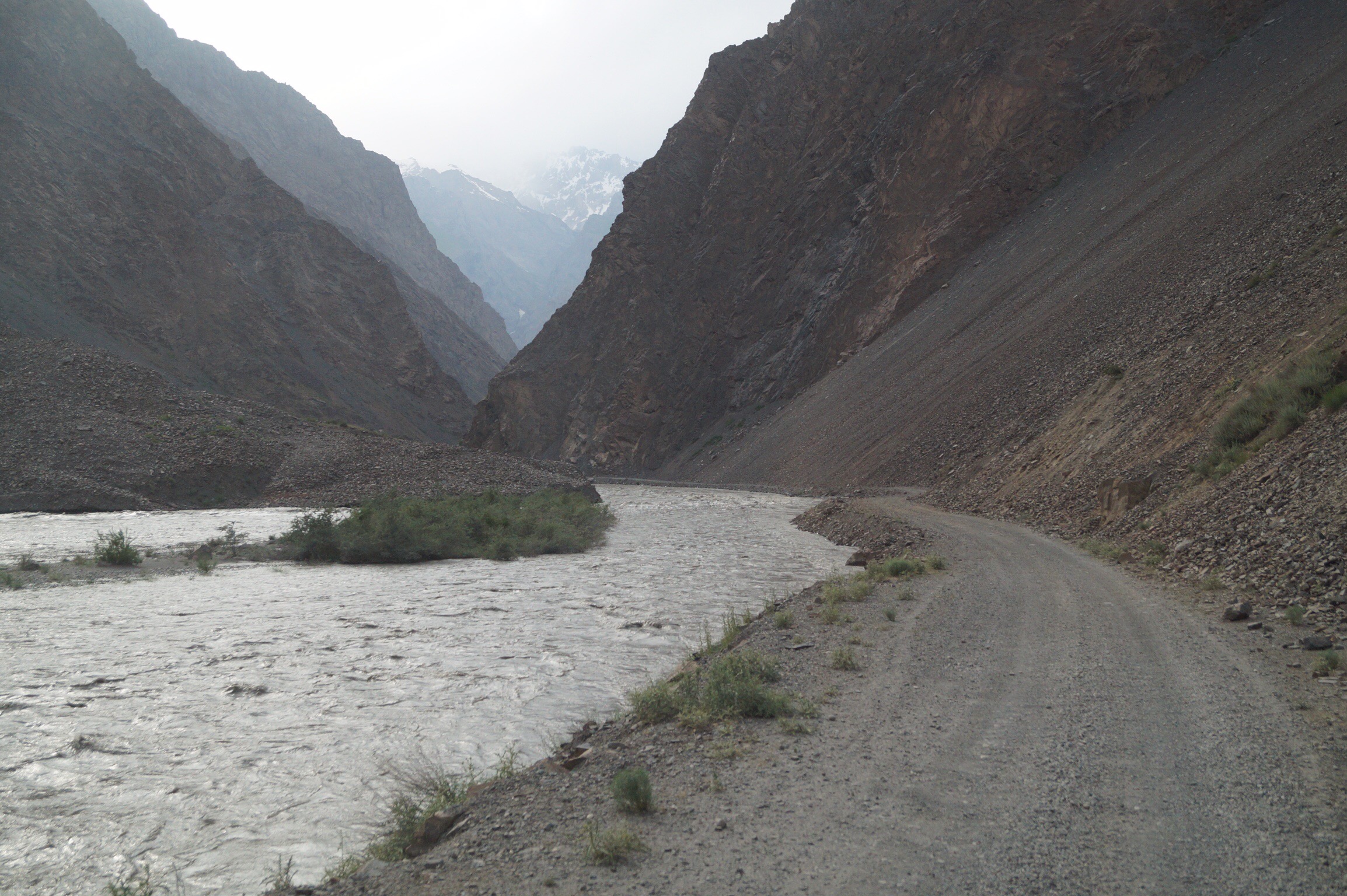
It was almost dark when we eventually found a spot off the road with no rock falls above and away from edge of the cliff dropping off into the river. In the end the only spot we could find was at an steep angle just a few metres off the road. We moved on early the next morning and drove for a couple of hours to find a flat spot for school, it's hard to concentrate on your sums when your pencil keeps on rolling off the table. The temperature was rising as we finished school and lunch and we were set for the afternoon of bumping along the next few kilometres, when Steve heard the tell tale "hiss" - a slow puncture. The flat meadow away from the dusty road, isn't a bad place to spend the afternoon getting all sweaty and dirty. It took a couple of hours to get back on the road. Thankfully a carload of friendly guys, happy to show off their masculinity, came along just at the right point. Helping us lift the 120kg tyre in its rack back onto position onto the back of the truck, a less than one minute job but the one thing the two of us can't do on our own.
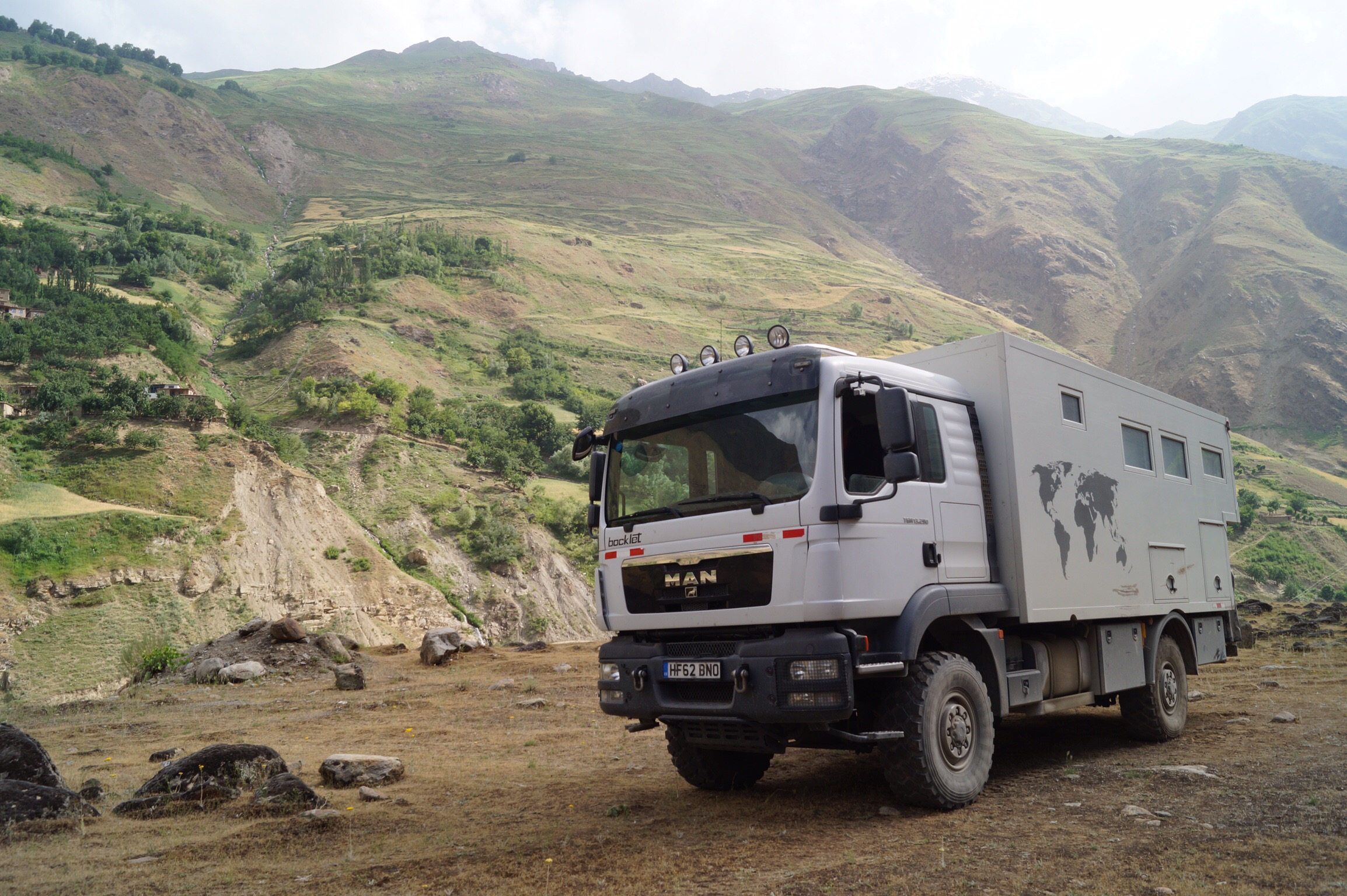
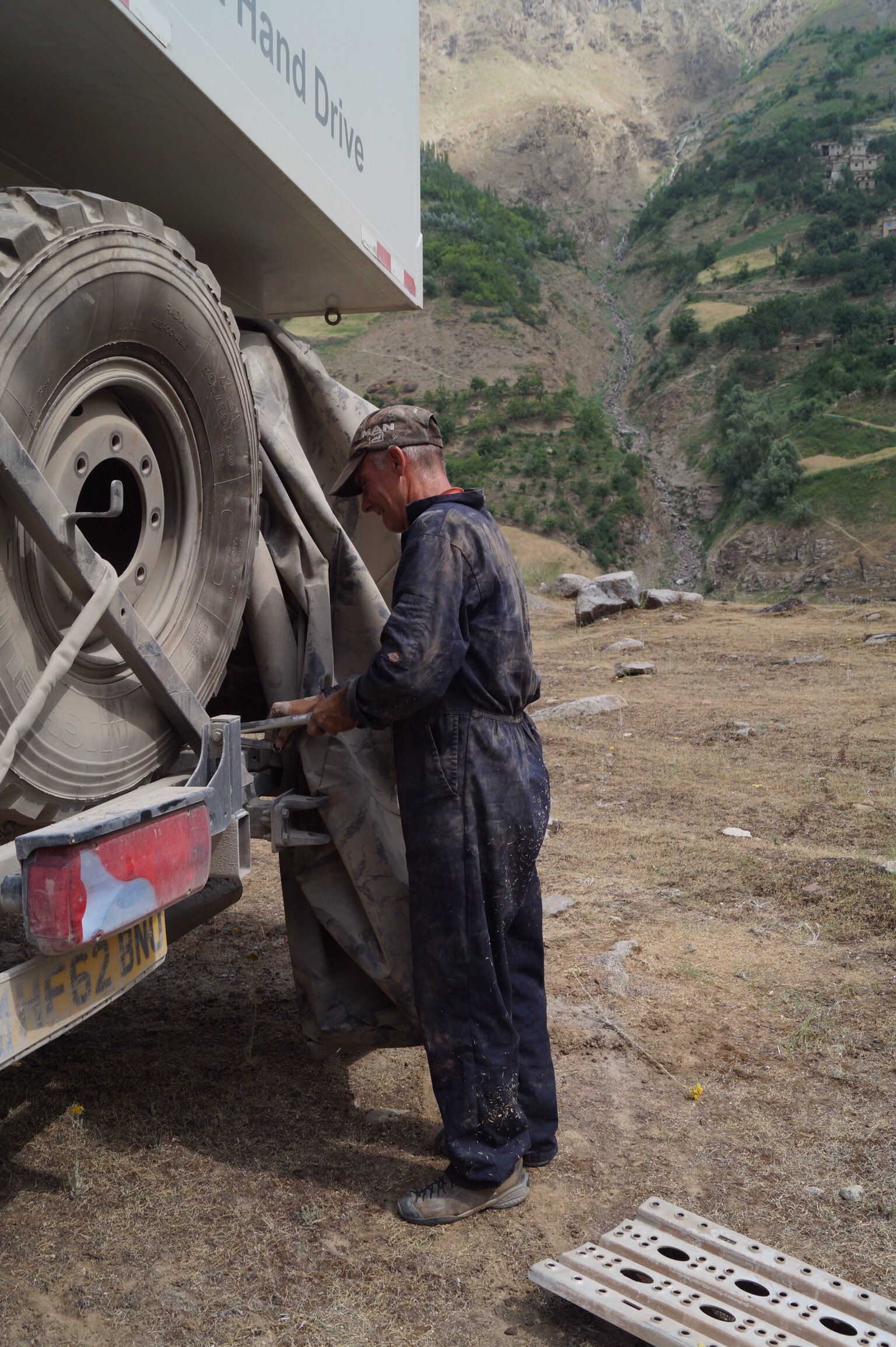
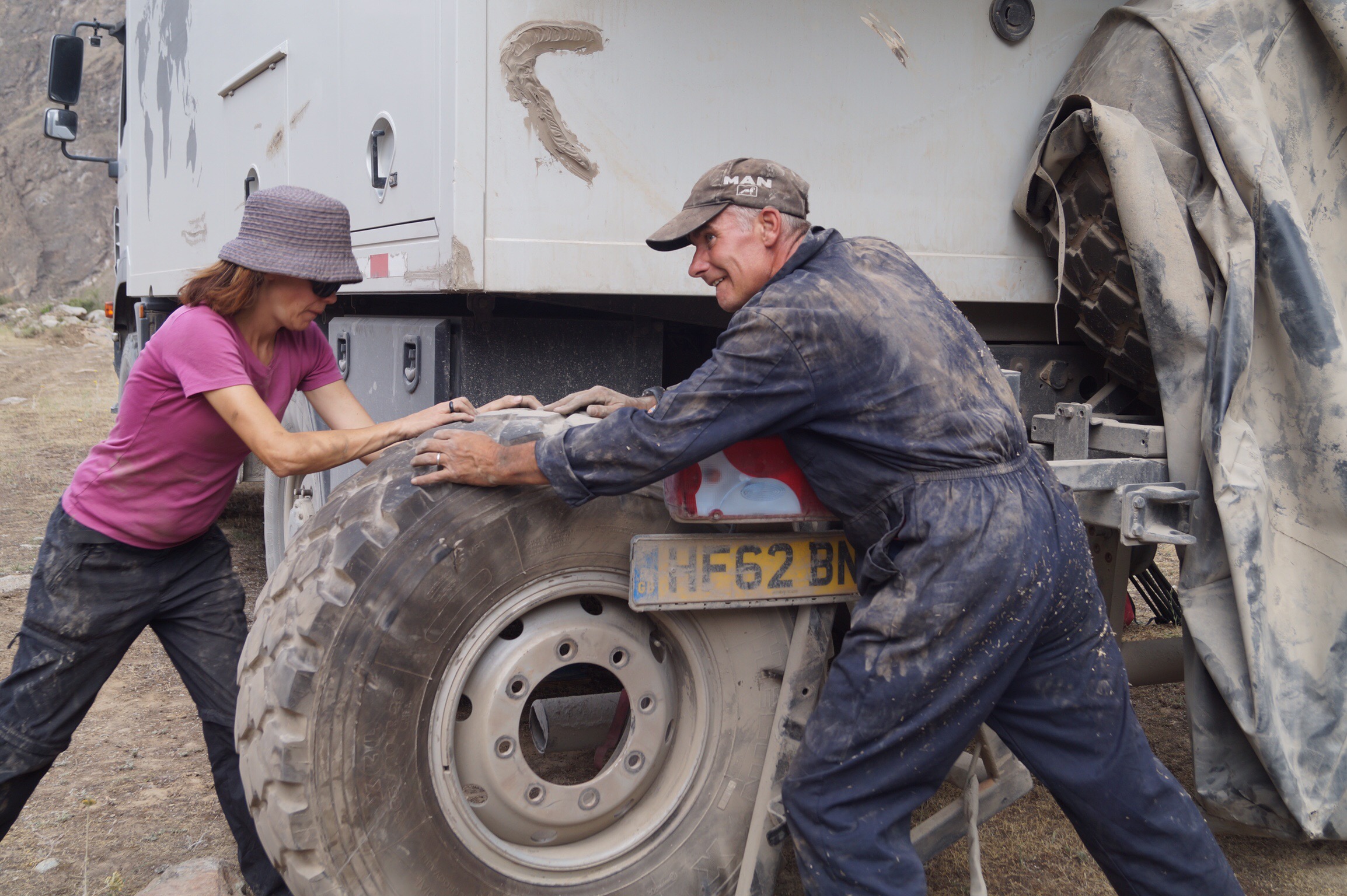
Both the Pamirs and the Wakan Corridor amazed us with their stark natural beauty and sense of remoteness. The constant dichotomy at looking up in awe at the mountains and down in horror at the road and the rushing river below us, was thrilling. We loved being out in the wilds; camping properly again; cooking outside; and the joy of the open road. But suddenly and almost unexpectedly it was over, after hundreds of bone jarring and shock absorber breaking kilometres, we hit Chinese laid smooth tar 50 km before the last pass. We cruised our way through villages, rather than squeezing our way through avenues of mulberry trees, and easily passed the double-length China bound articulated lorries (I kid you not!) we had been praying not to meet on the tightest corners. The river then veered off to the left at the bottom of the pass, as we headed up and onwards to the hot dry hills of central Tajikistan. Pamirs - we will miss you.
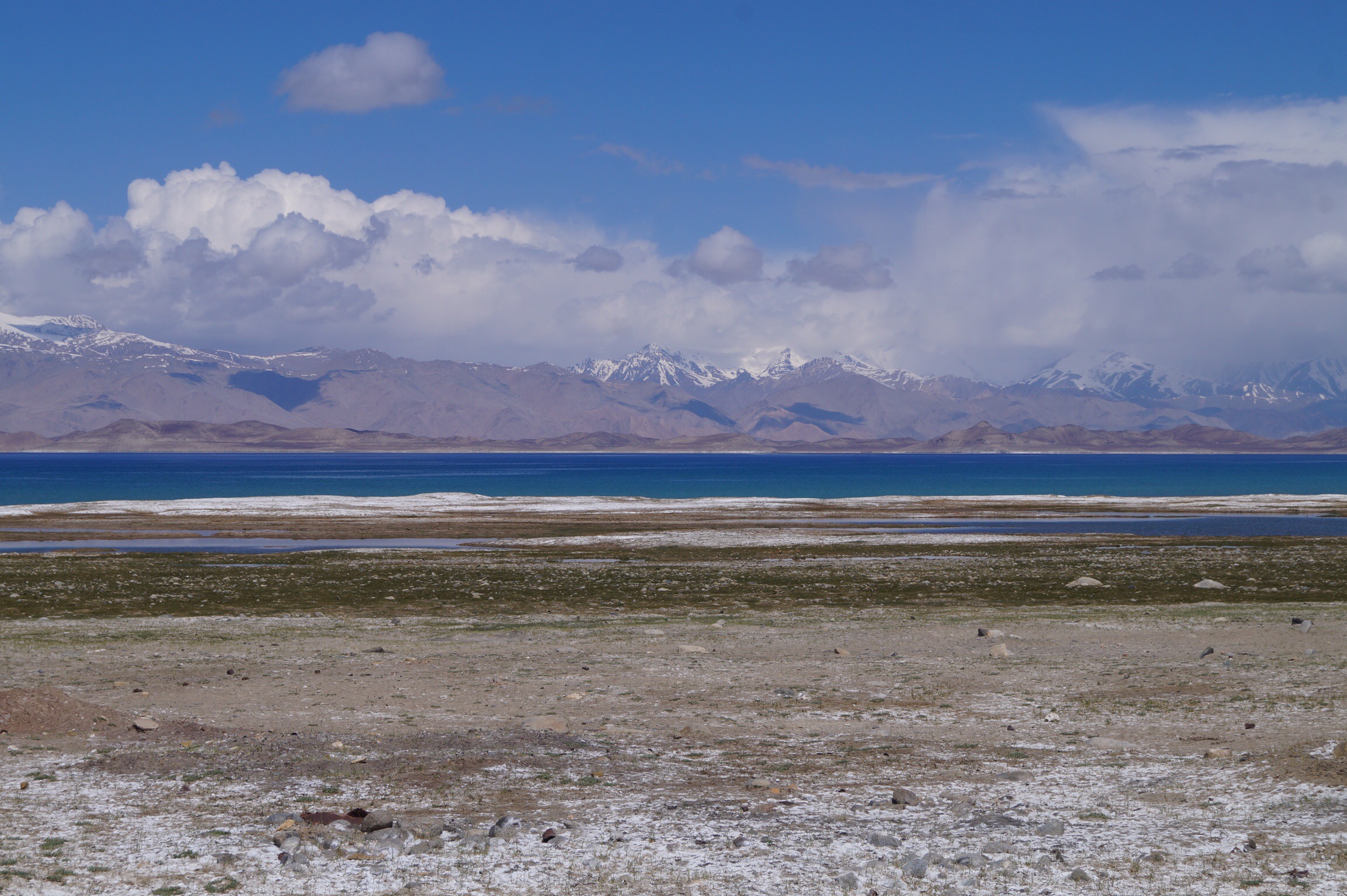
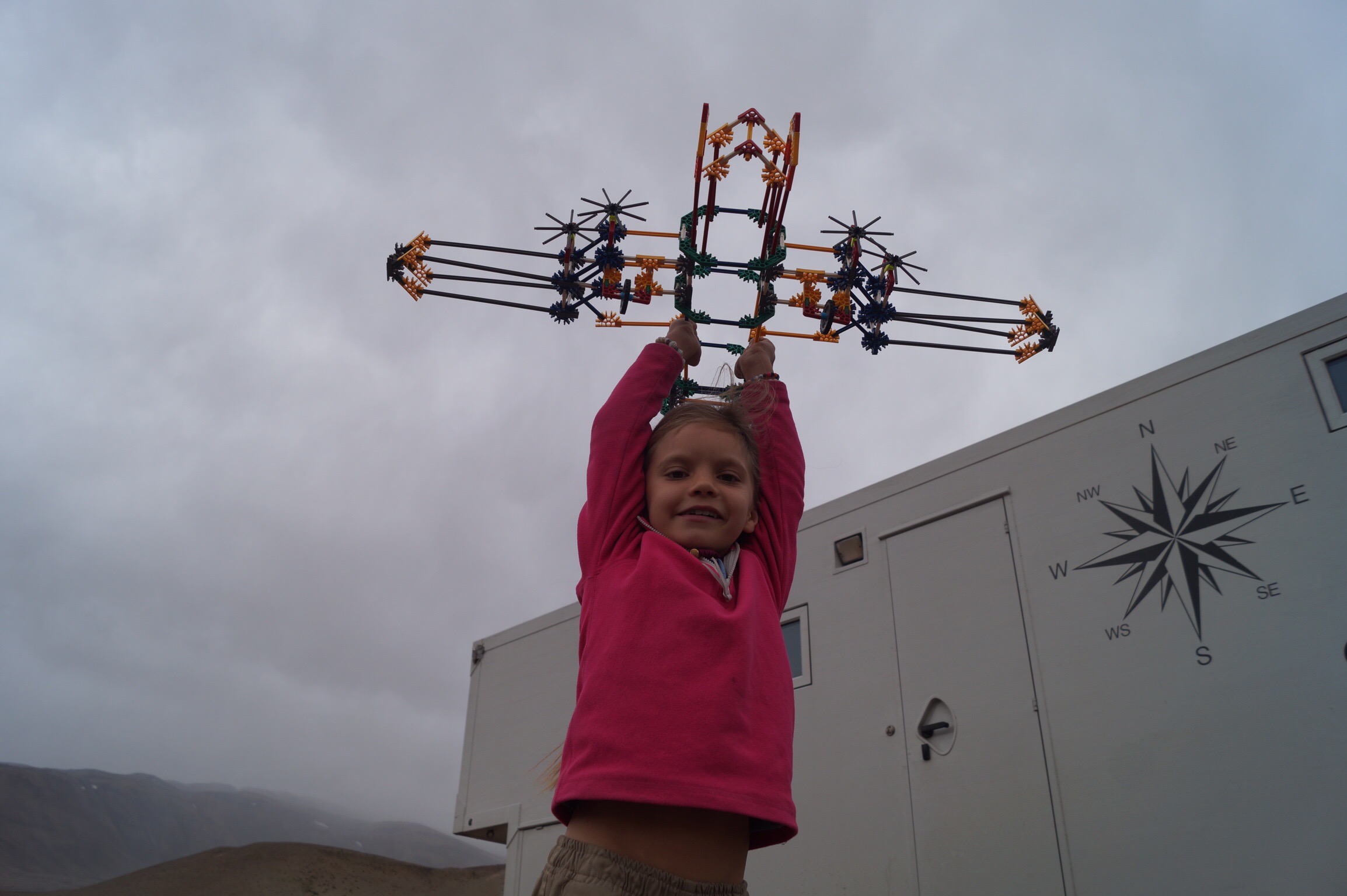
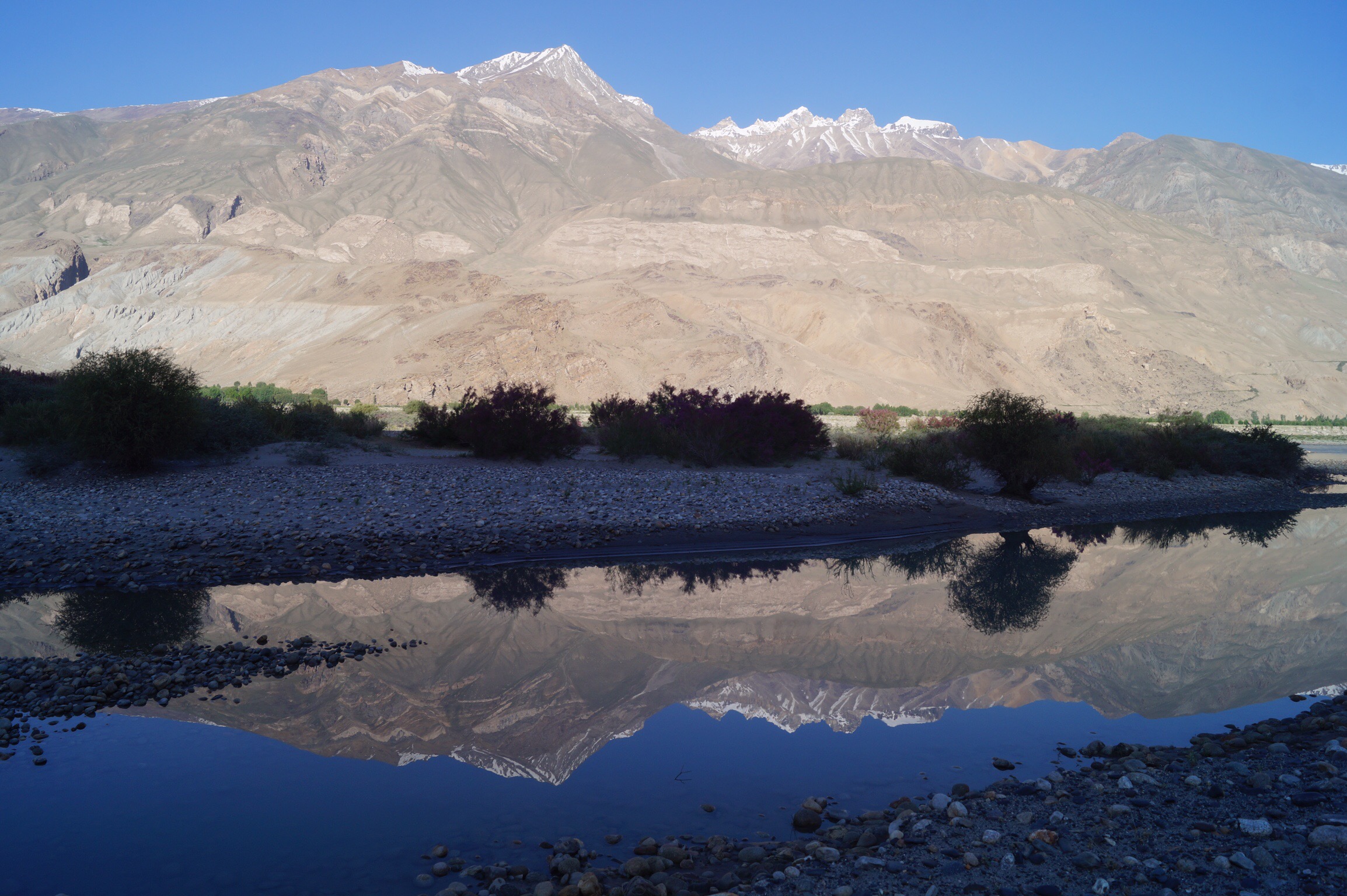
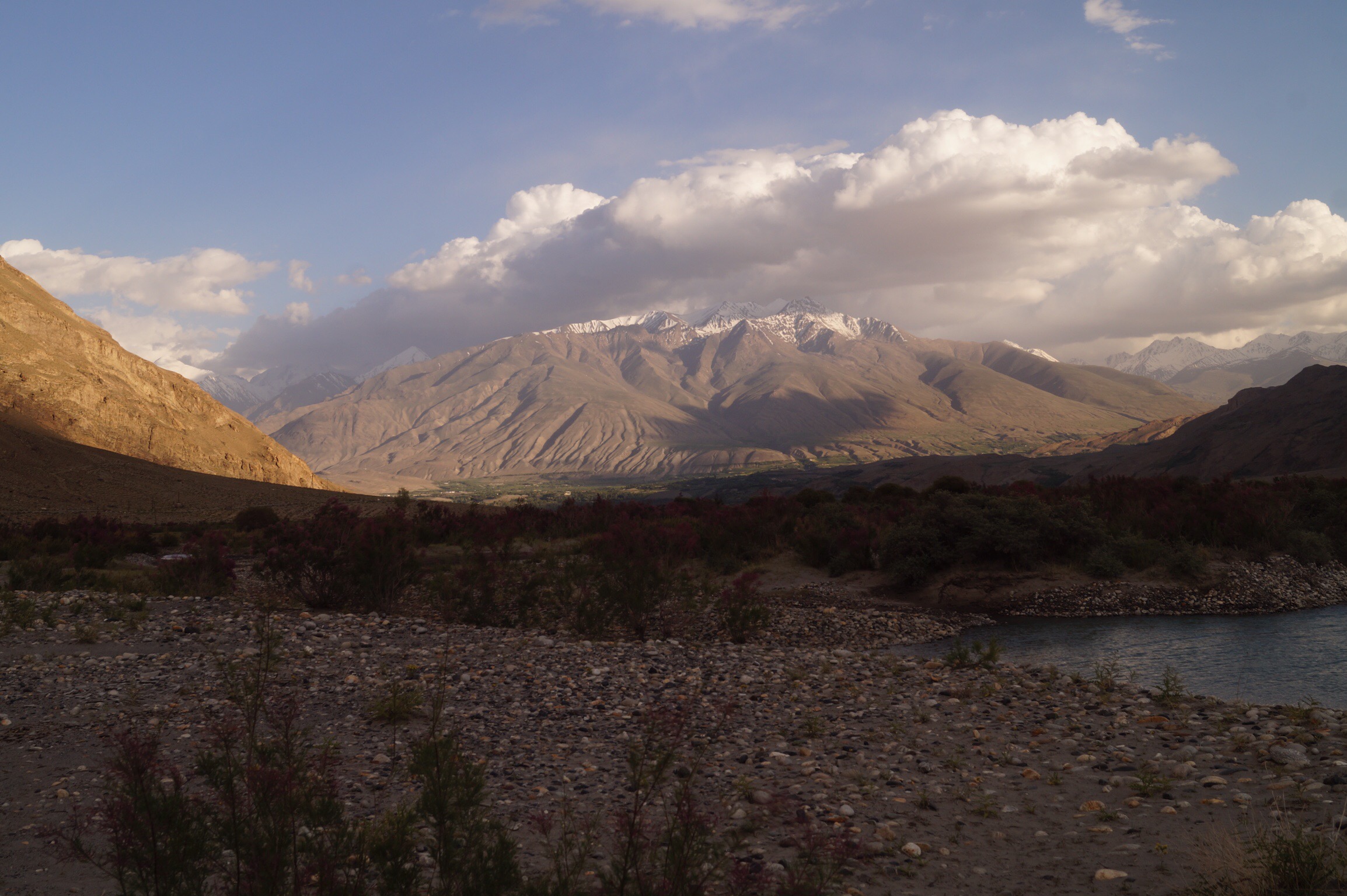
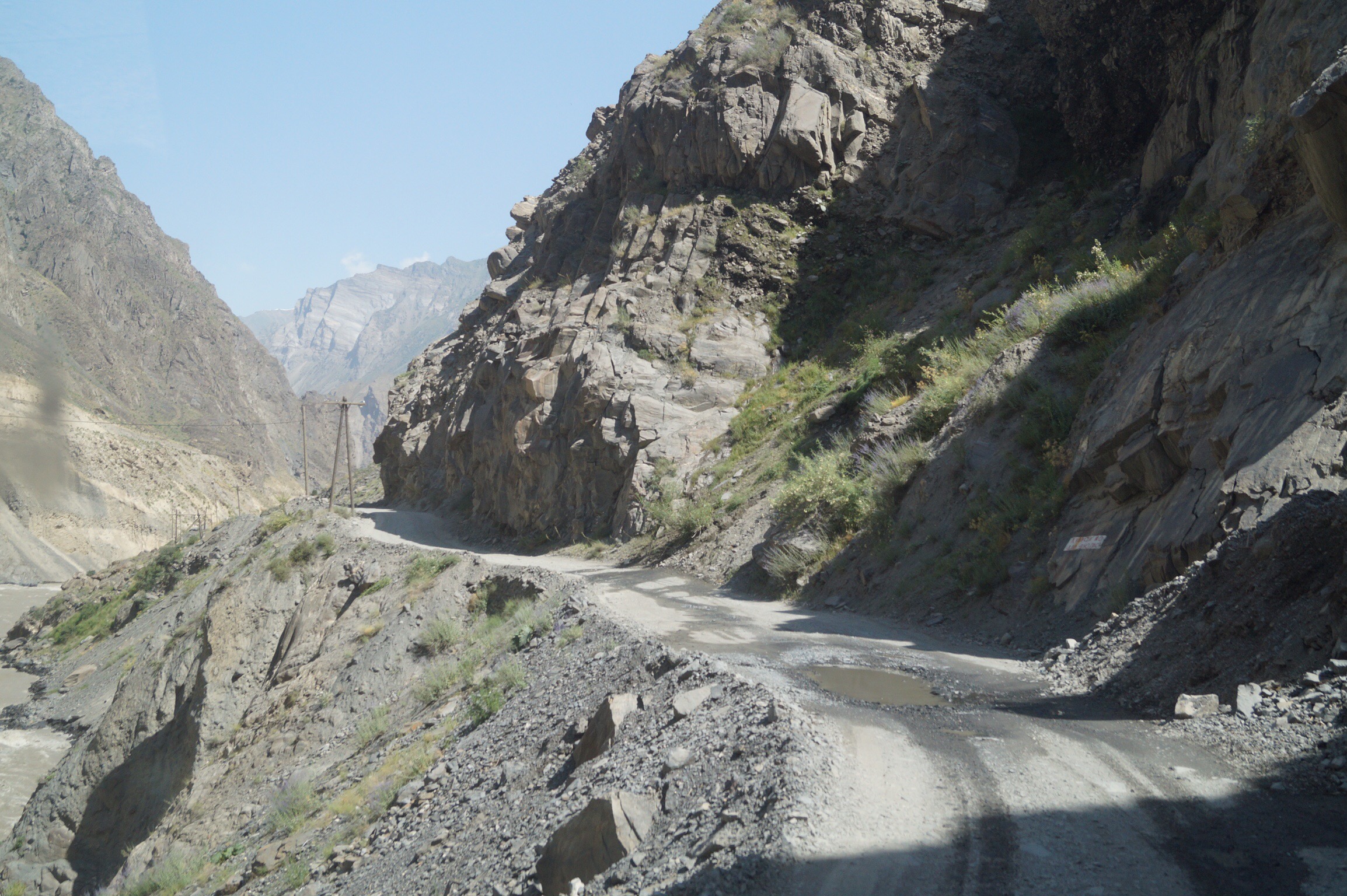
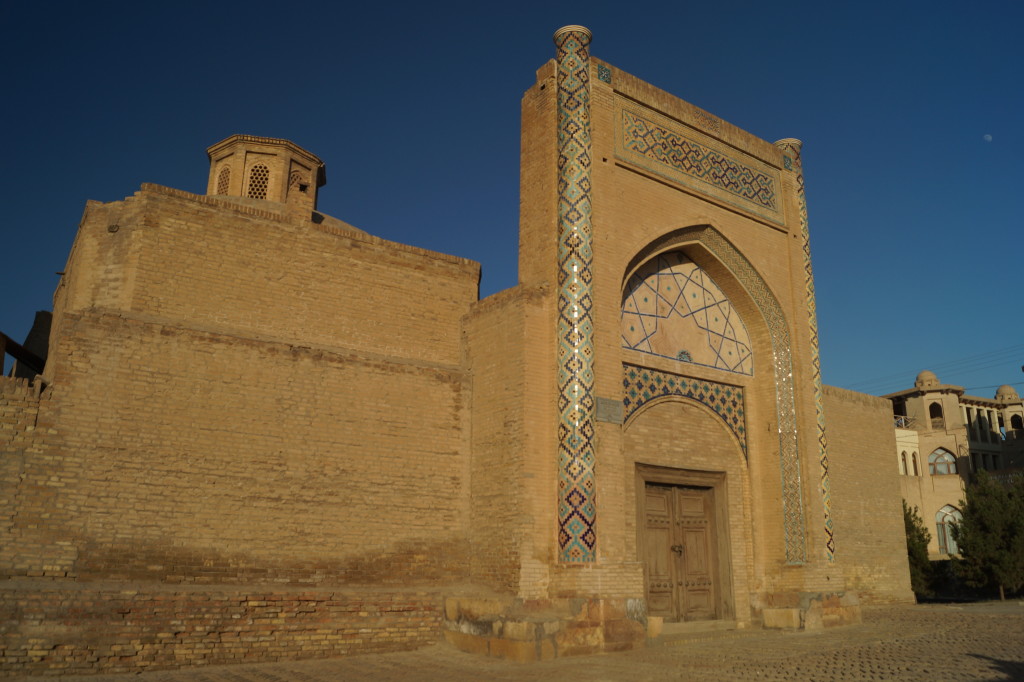
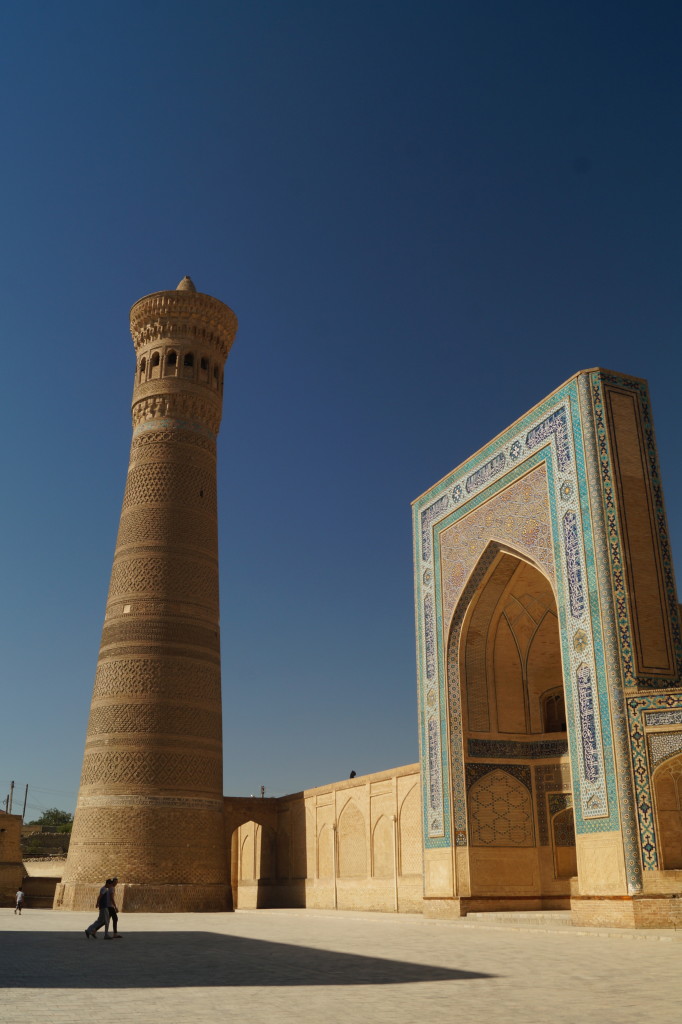
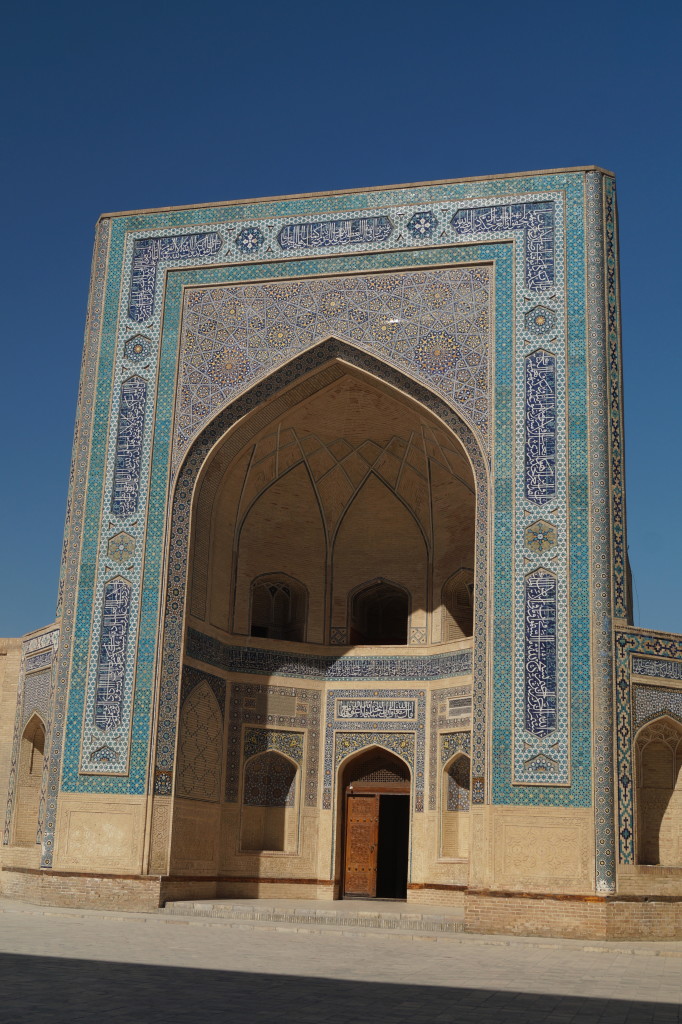
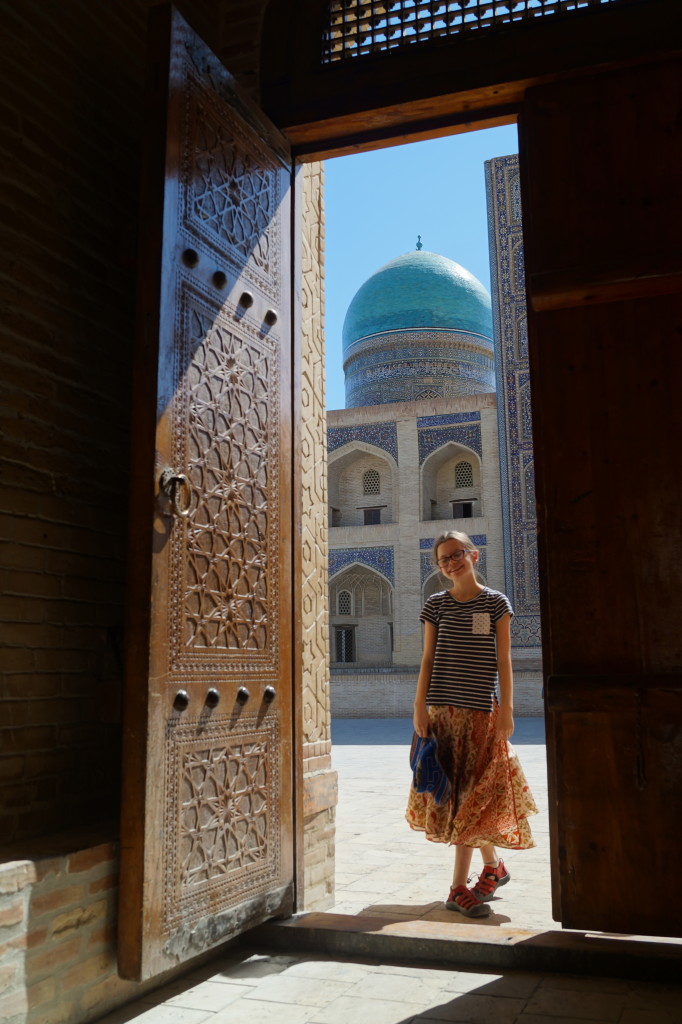
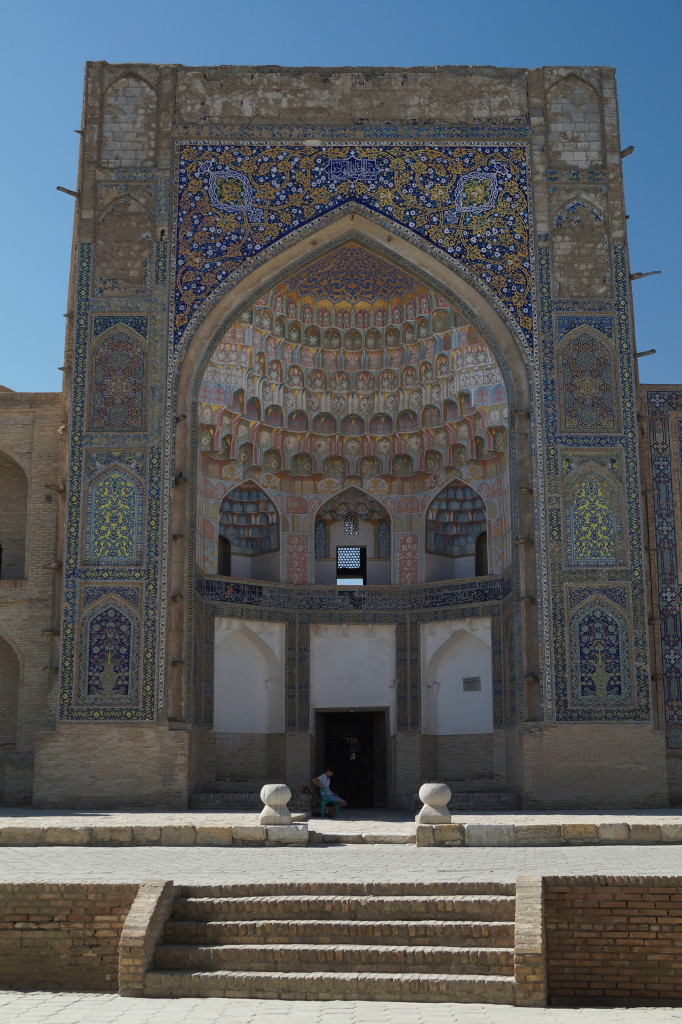
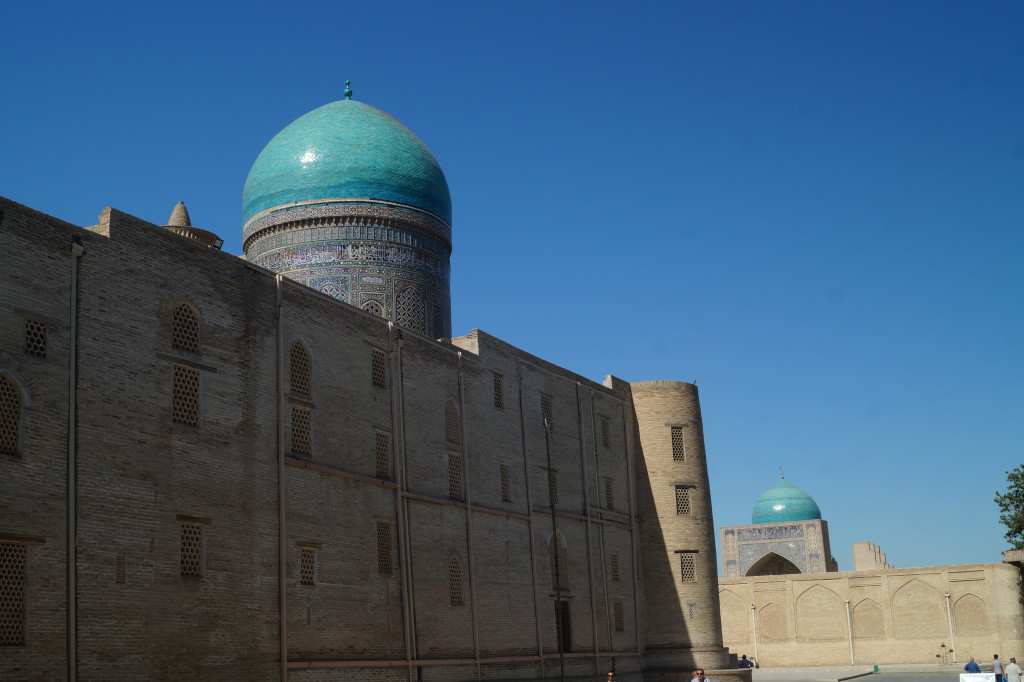
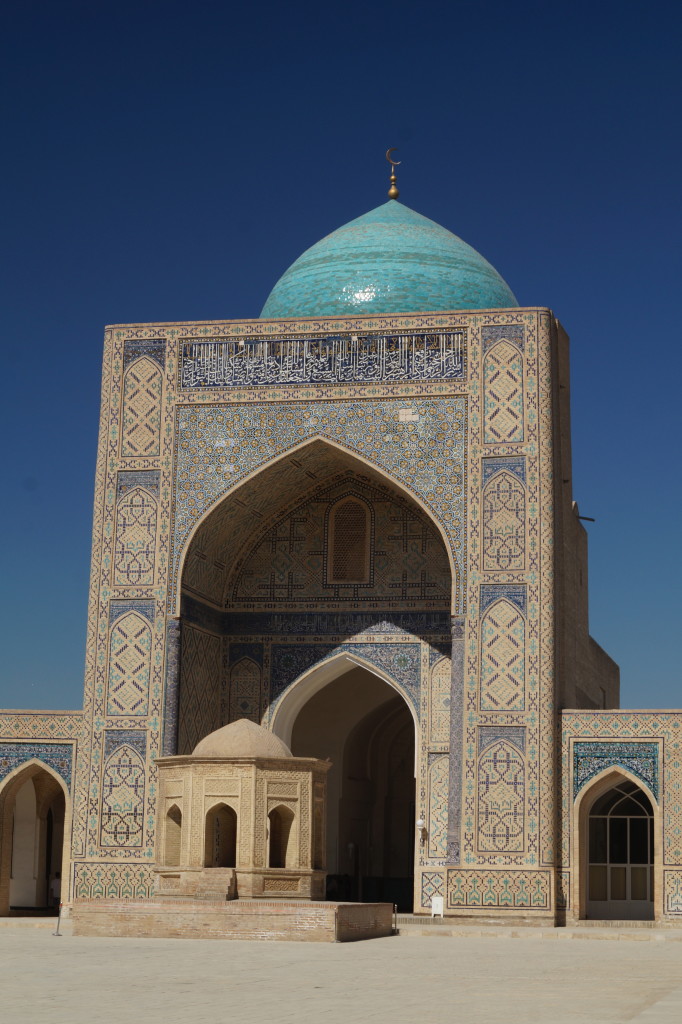
 The whole region was the backdrop of a period of high drama and intrigue in the Victorian era between the British and the Russians. Dramatically named the "Great Game" in English or the "Tournament of Shadows" in Russian. This struggle for power by the two great empires, reads like something out of a historical adventure novel. Steve was keen to see the bug infested pit where two British officers, Charles Stoddart and Arthur Conolly were held by the Emir of Bukhara for 3 years before they were executed. I decided to skip that delight and sweat quietly in the shade.
The whole region was the backdrop of a period of high drama and intrigue in the Victorian era between the British and the Russians. Dramatically named the "Great Game" in English or the "Tournament of Shadows" in Russian. This struggle for power by the two great empires, reads like something out of a historical adventure novel. Steve was keen to see the bug infested pit where two British officers, Charles Stoddart and Arthur Conolly were held by the Emir of Bukhara for 3 years before they were executed. I decided to skip that delight and sweat quietly in the shade.
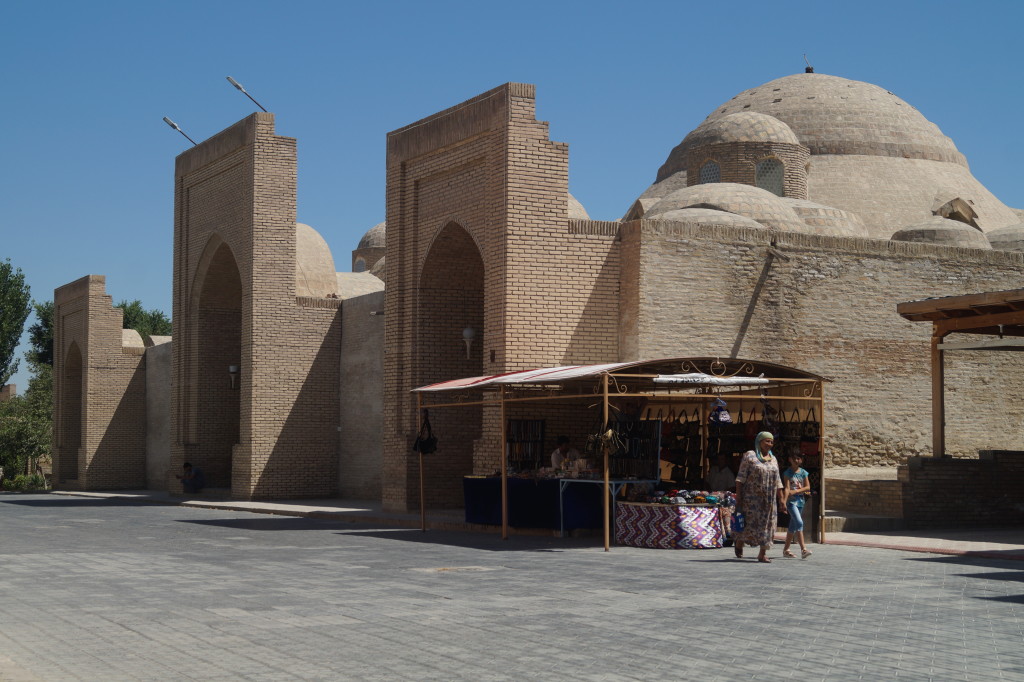
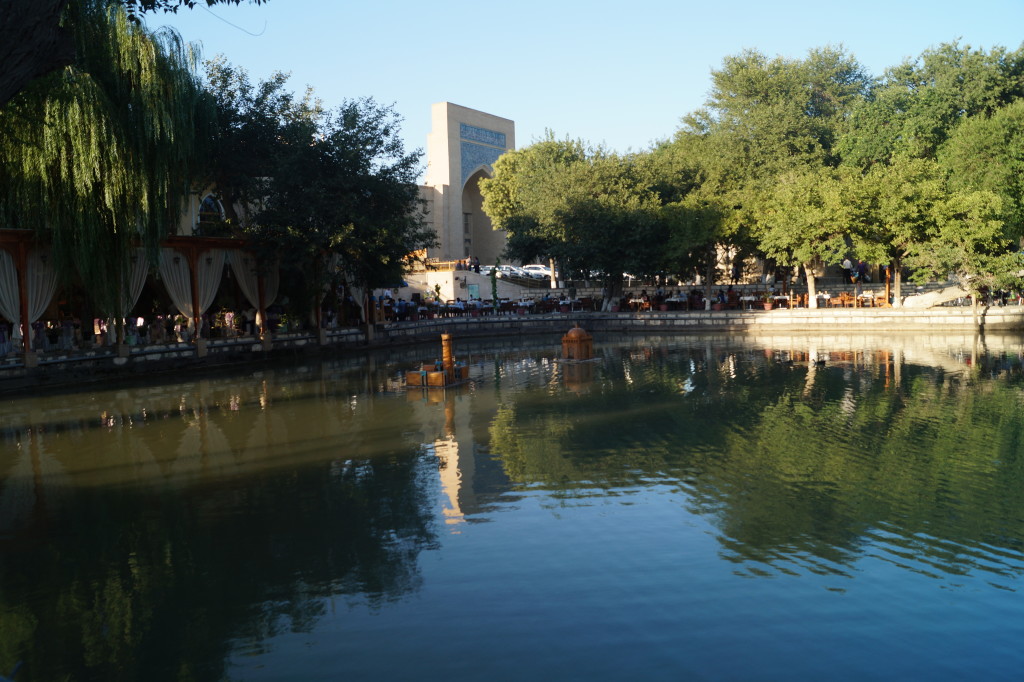
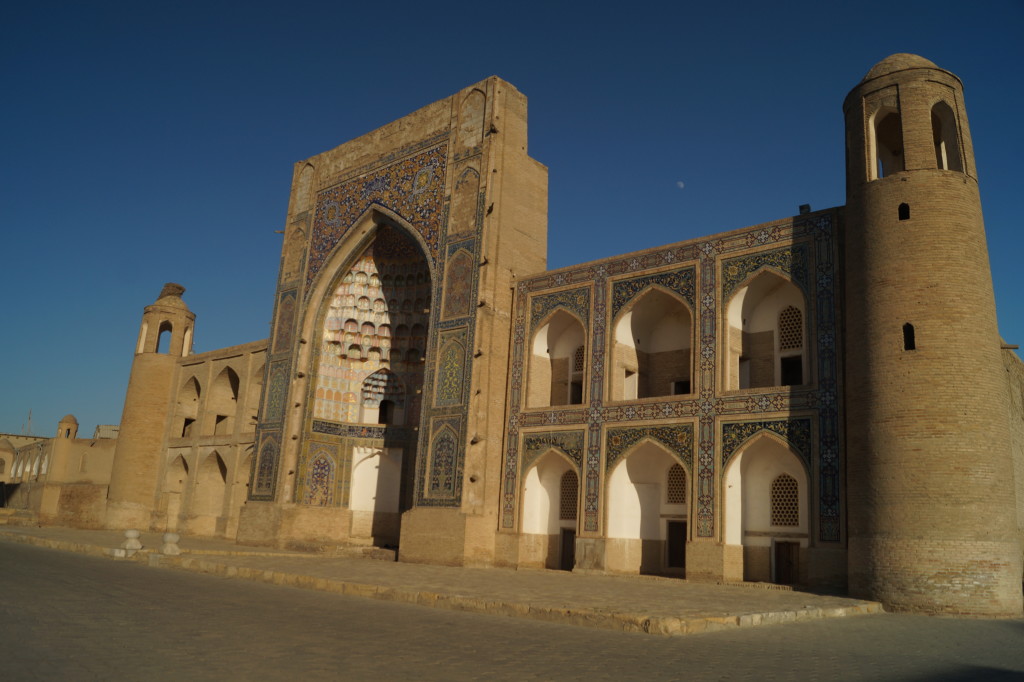
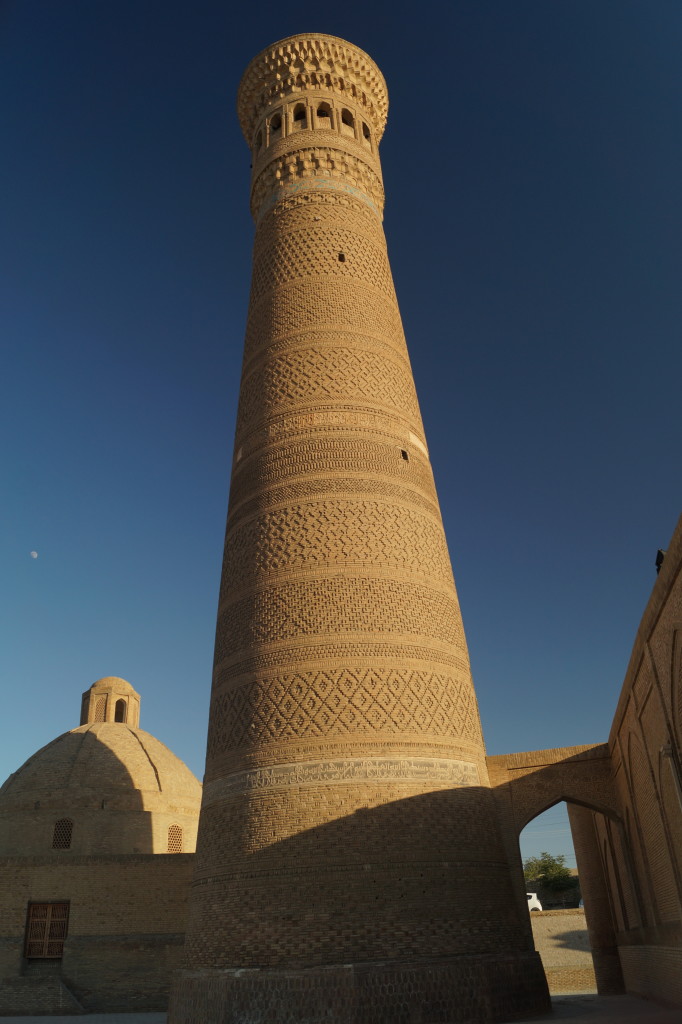
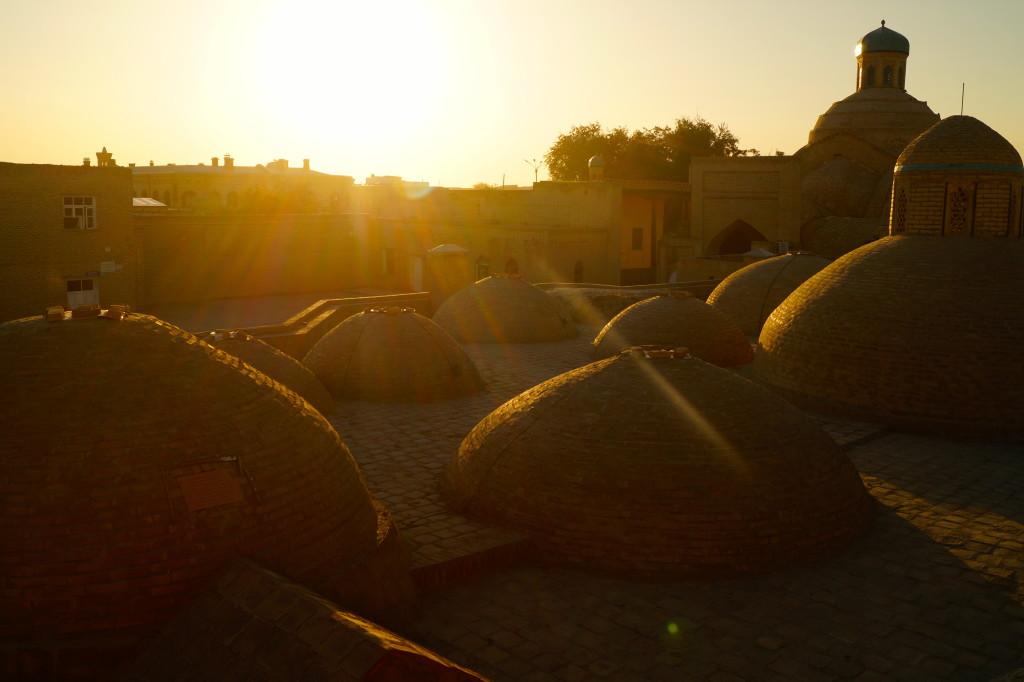
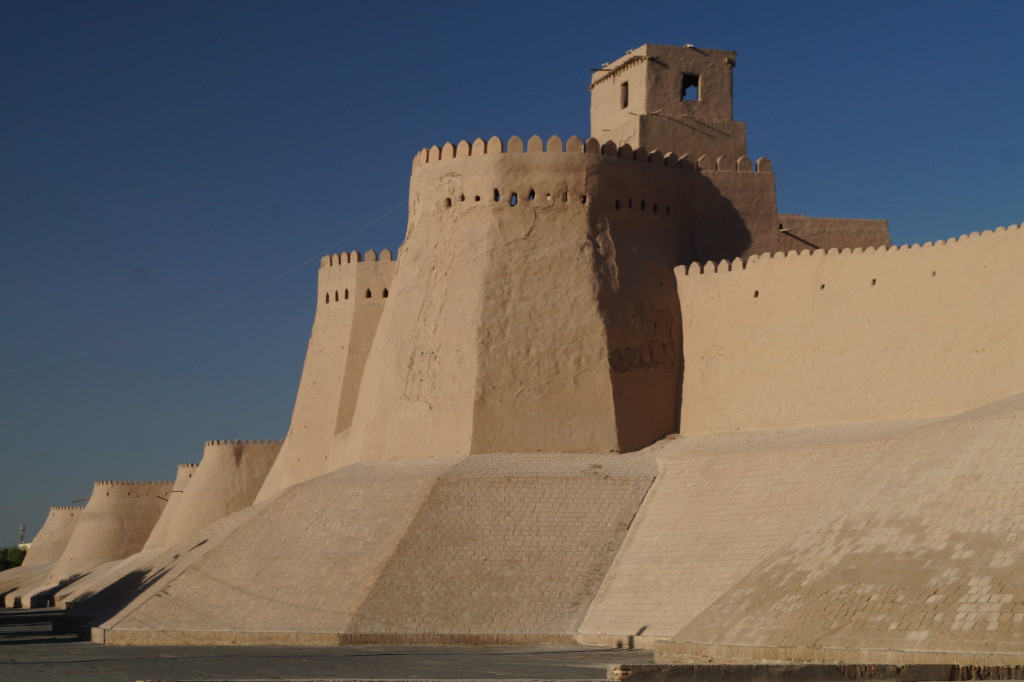
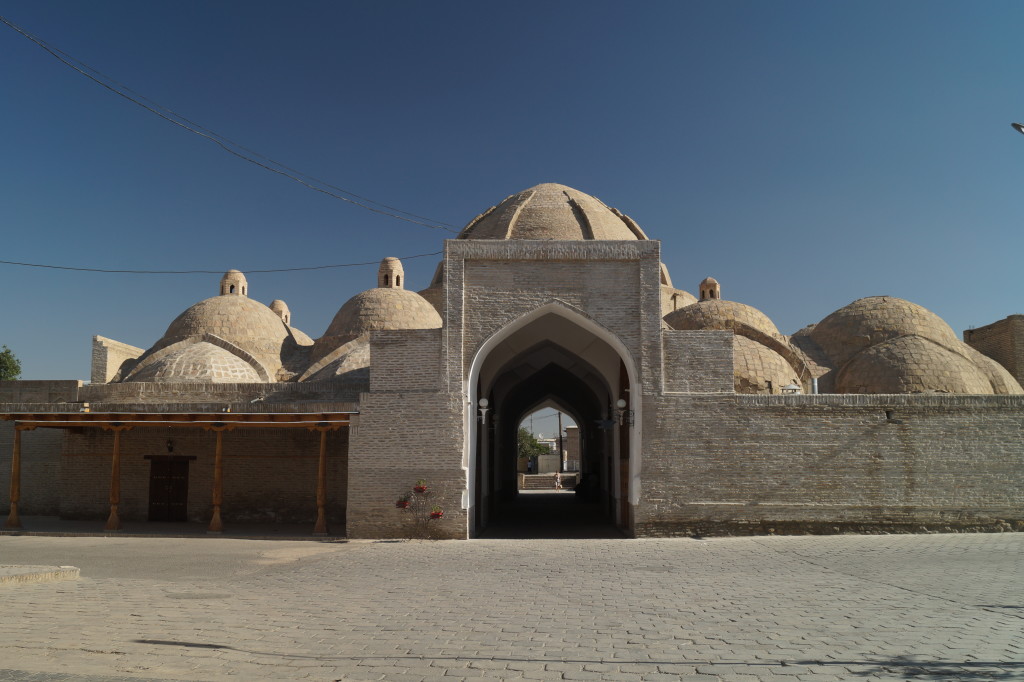
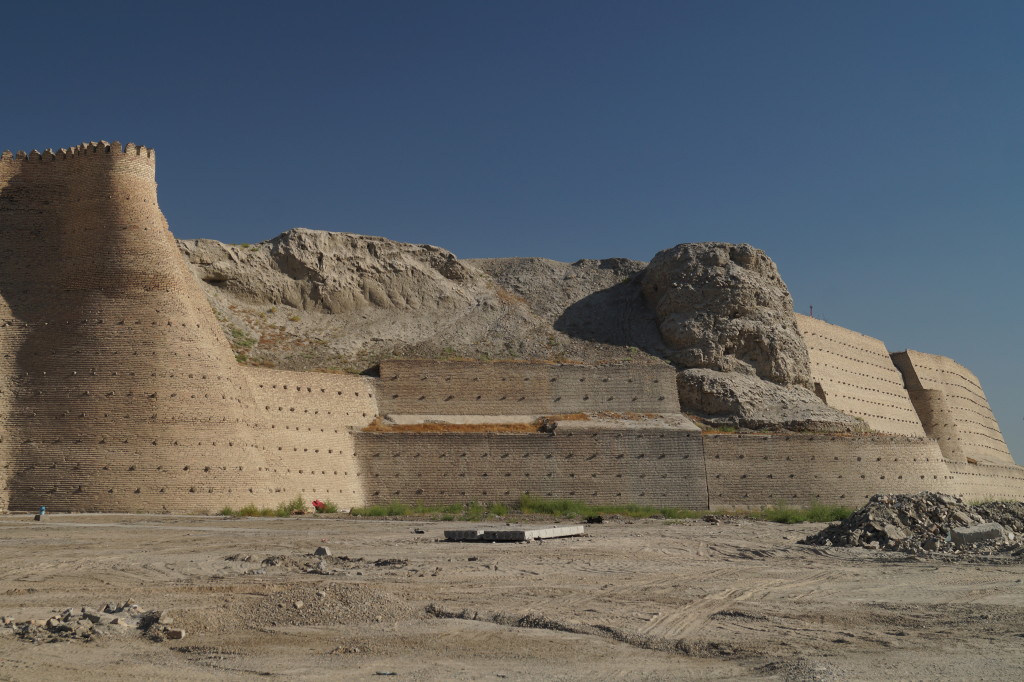
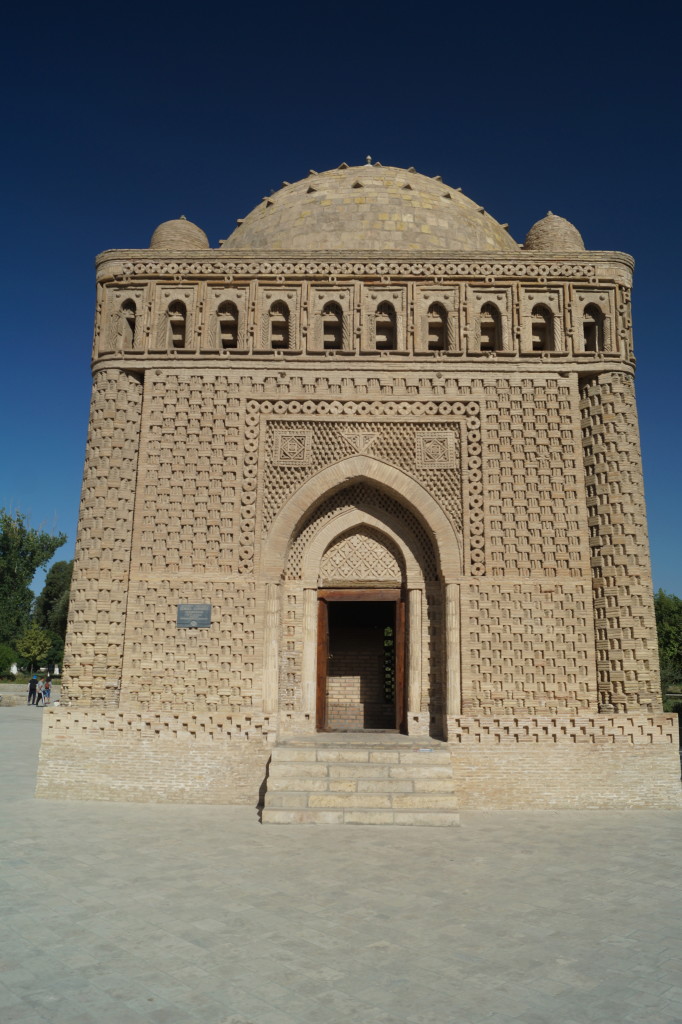
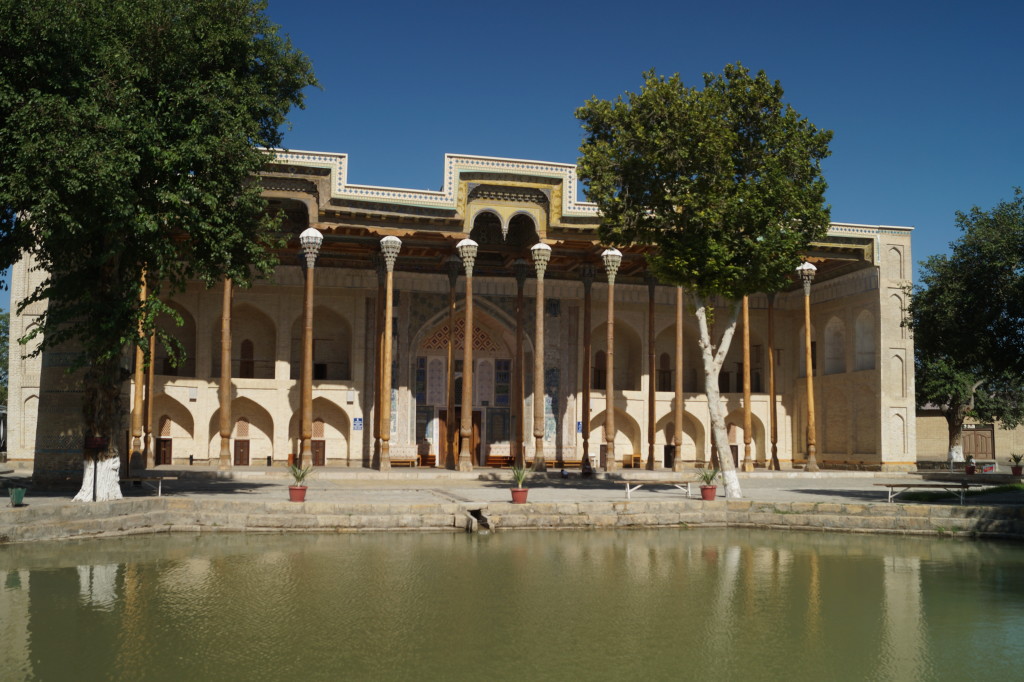 Our energy levels were much revived when we discovered a smart tea shop that served bowls of dried fruits, nuts, crystallised sugar and eastern sweets with their delicious spiced tea. Such a success we went back the following day when we were flagging. With such a sugar rush we were able to take in a few more blue tiled facades on the way home.
Our parking spot in Khiva was even more impressive just outside the high mud walls of the citadel. In the late evening sunlight the whole city glowed orange from the west. We climbed up onto the walls to view the compact city below us. In the northern end people had emerged from their houses to tend their small gardens and chat to their neighbours. Whilst in the southern part the blue tile of mosques, madrassas and palaces contrasted beautifully with the surrounding cinnamon walls.
Our energy levels were much revived when we discovered a smart tea shop that served bowls of dried fruits, nuts, crystallised sugar and eastern sweets with their delicious spiced tea. Such a success we went back the following day when we were flagging. With such a sugar rush we were able to take in a few more blue tiled facades on the way home.
Our parking spot in Khiva was even more impressive just outside the high mud walls of the citadel. In the late evening sunlight the whole city glowed orange from the west. We climbed up onto the walls to view the compact city below us. In the northern end people had emerged from their houses to tend their small gardens and chat to their neighbours. Whilst in the southern part the blue tile of mosques, madrassas and palaces contrasted beautifully with the surrounding cinnamon walls.
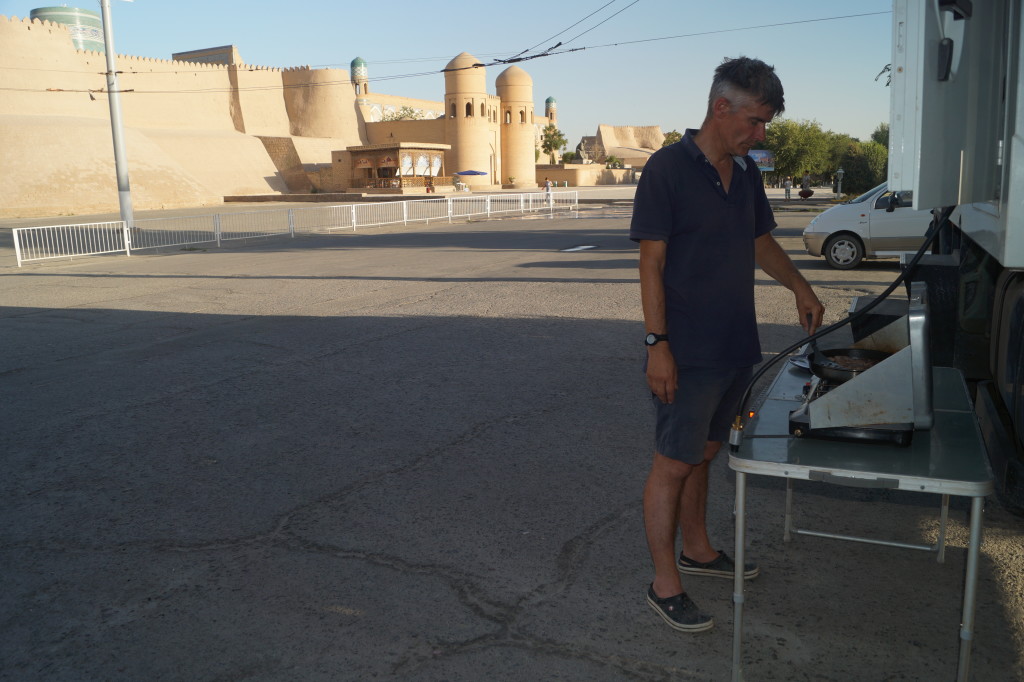 The walled city was famous for its ancient slave market and, like Bukhara, Khiva seemed to be stuffed full of blue domes, amazingly blue tiled portals and palaces. It seemed more of museum than a living city, however the market just outside the citadel seemed to be bustling.
The walled city was famous for its ancient slave market and, like Bukhara, Khiva seemed to be stuffed full of blue domes, amazingly blue tiled portals and palaces. It seemed more of museum than a living city, however the market just outside the citadel seemed to be bustling.
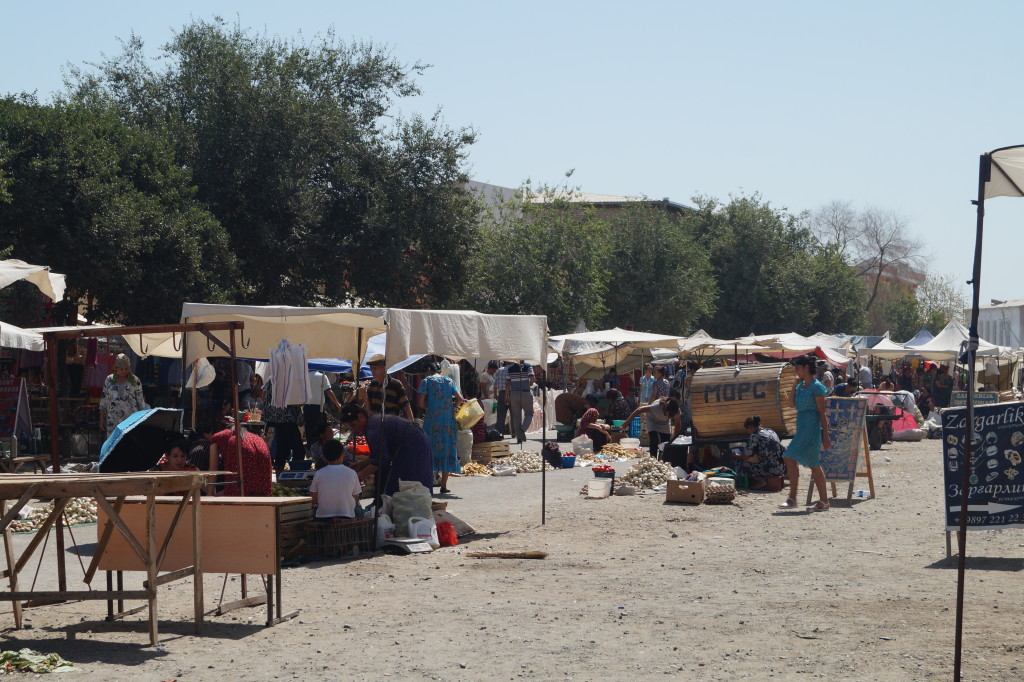 The roof of Juma Mosque is held up by 218 intricately carved posts, a striking sight for the shadows they created. Climbing the minaret, patterned with alternative stripes of blue and green tiles, gave us an arresting view of the whole city. Especially the Kalta Minor Minaret which was only partially completed by 1855, when the Khan died. This truncated tower with its strikingly patterned facade was supposed to allow the Khan to see all the way to Bukhara. Already eye-catching it would have been breathtaking if it had been finished. Weirdly, as we climbed down the shin high steps made of twisted trunks but worn smooth by centuries of use, we all developed painful cramps in our legs. Although we were well hydrated I guess the extreme heat does strange things to your body, it was time to retreat to the shade.
The roof of Juma Mosque is held up by 218 intricately carved posts, a striking sight for the shadows they created. Climbing the minaret, patterned with alternative stripes of blue and green tiles, gave us an arresting view of the whole city. Especially the Kalta Minor Minaret which was only partially completed by 1855, when the Khan died. This truncated tower with its strikingly patterned facade was supposed to allow the Khan to see all the way to Bukhara. Already eye-catching it would have been breathtaking if it had been finished. Weirdly, as we climbed down the shin high steps made of twisted trunks but worn smooth by centuries of use, we all developed painful cramps in our legs. Although we were well hydrated I guess the extreme heat does strange things to your body, it was time to retreat to the shade.
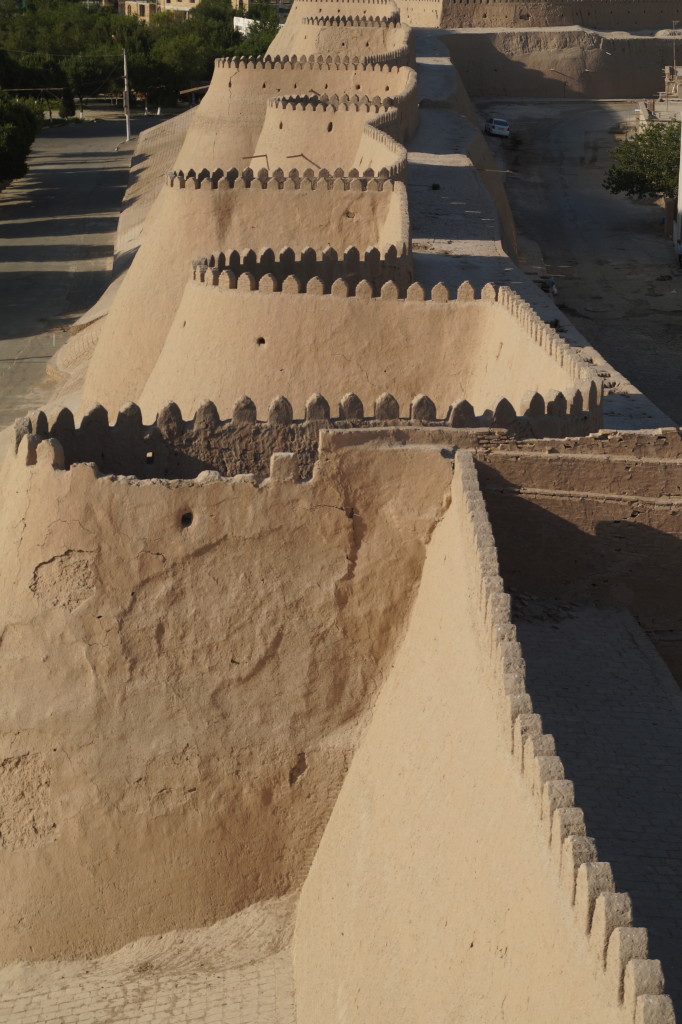
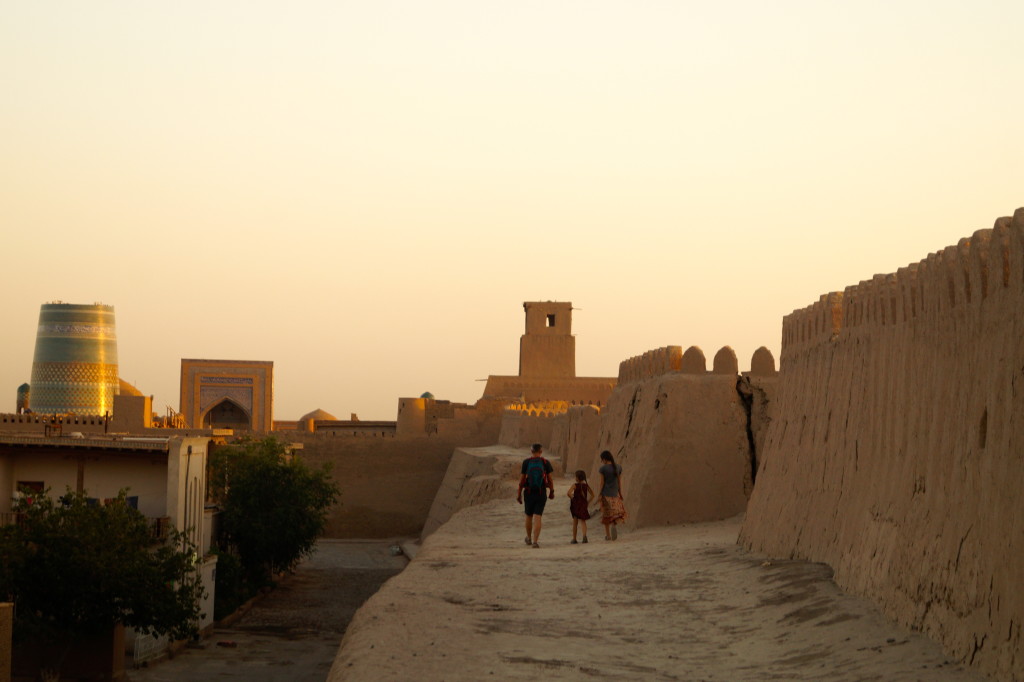
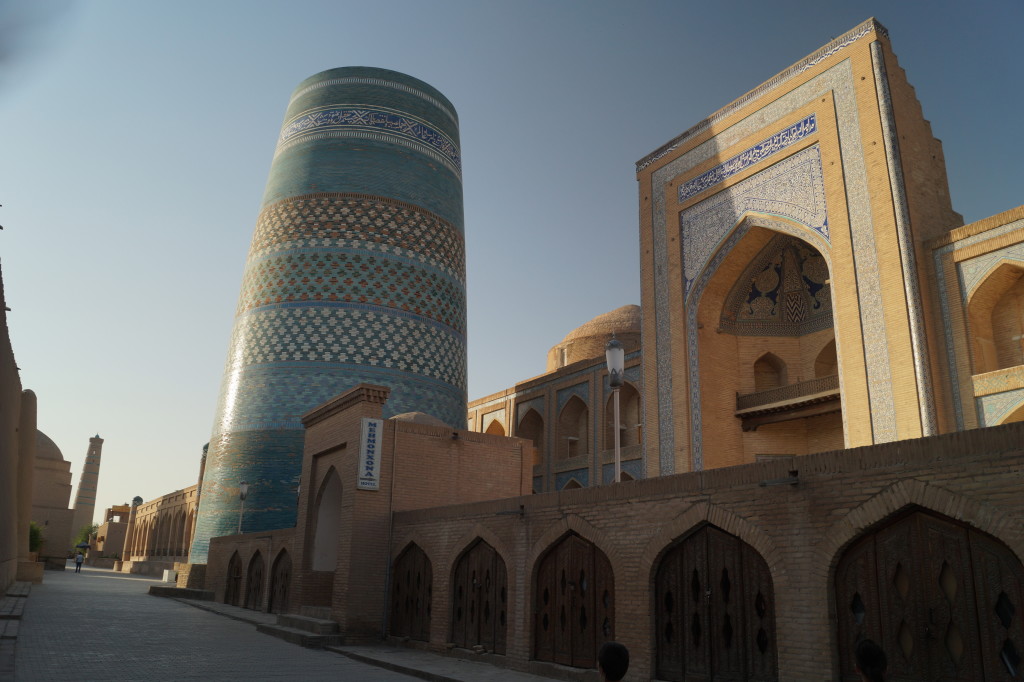
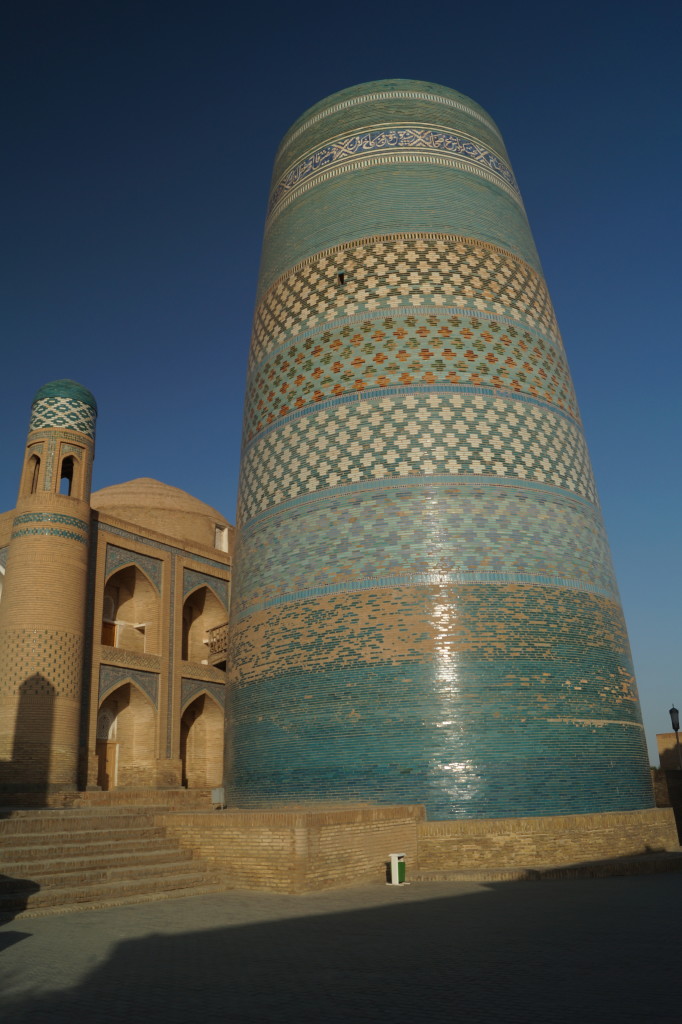
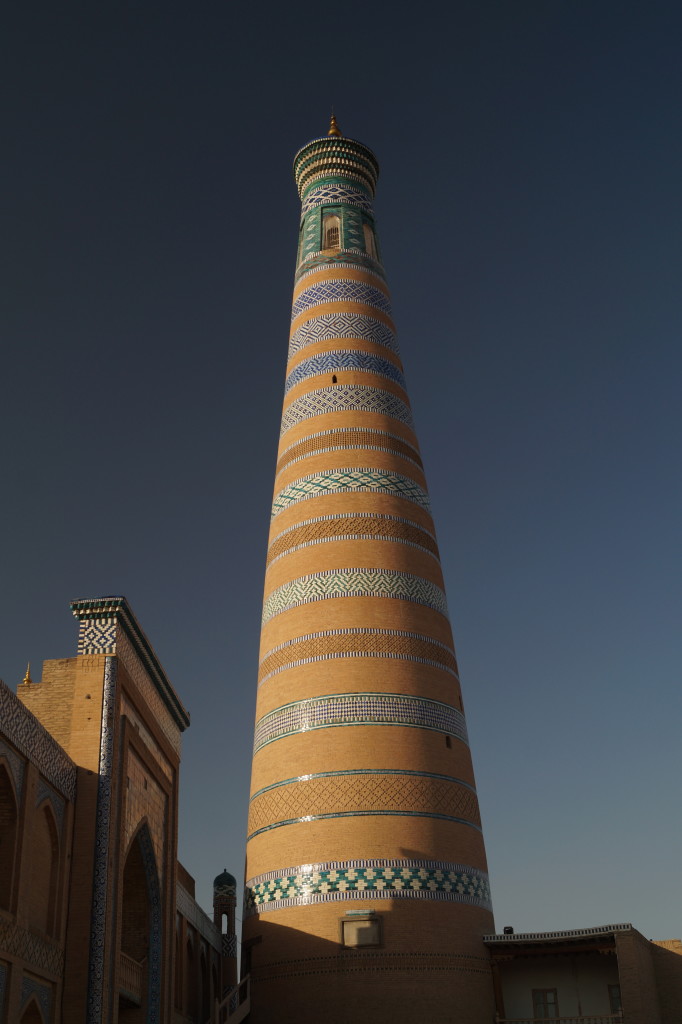 That afternoon the truck's internal thermometer hit 54°C! Even with all the windows open and the fans on, it was hard to dissipate the heat. We had all hoped to sleep in one of the hostel's air conditioned rooms that night but we were worried about getting the truck cool enough. Steve gallantly offered to sleep in the truck with all the windows open to cool it in the lower nighttime temperatures, a balmy 38° C.
That afternoon the truck's internal thermometer hit 54°C! Even with all the windows open and the fans on, it was hard to dissipate the heat. We had all hoped to sleep in one of the hostel's air conditioned rooms that night but we were worried about getting the truck cool enough. Steve gallantly offered to sleep in the truck with all the windows open to cool it in the lower nighttime temperatures, a balmy 38° C.
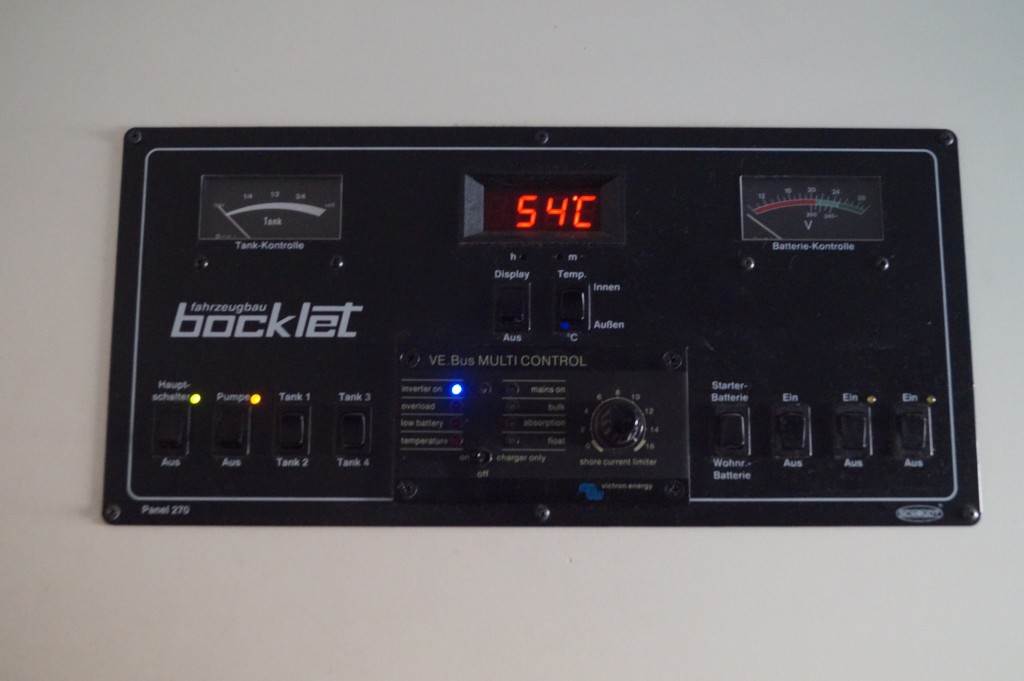
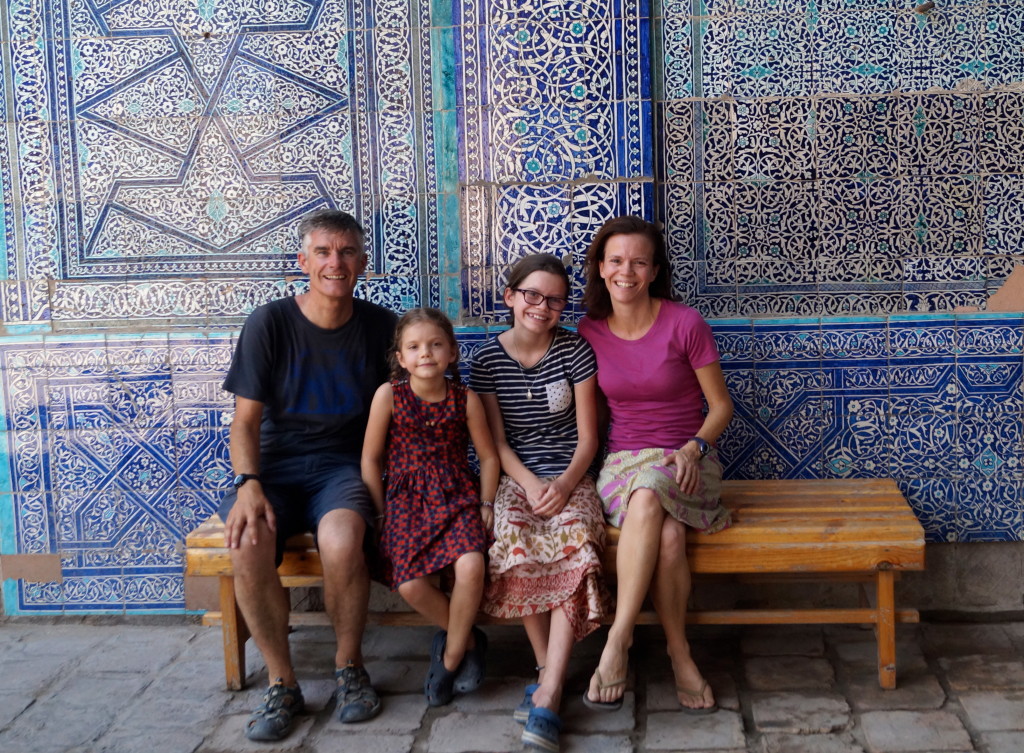
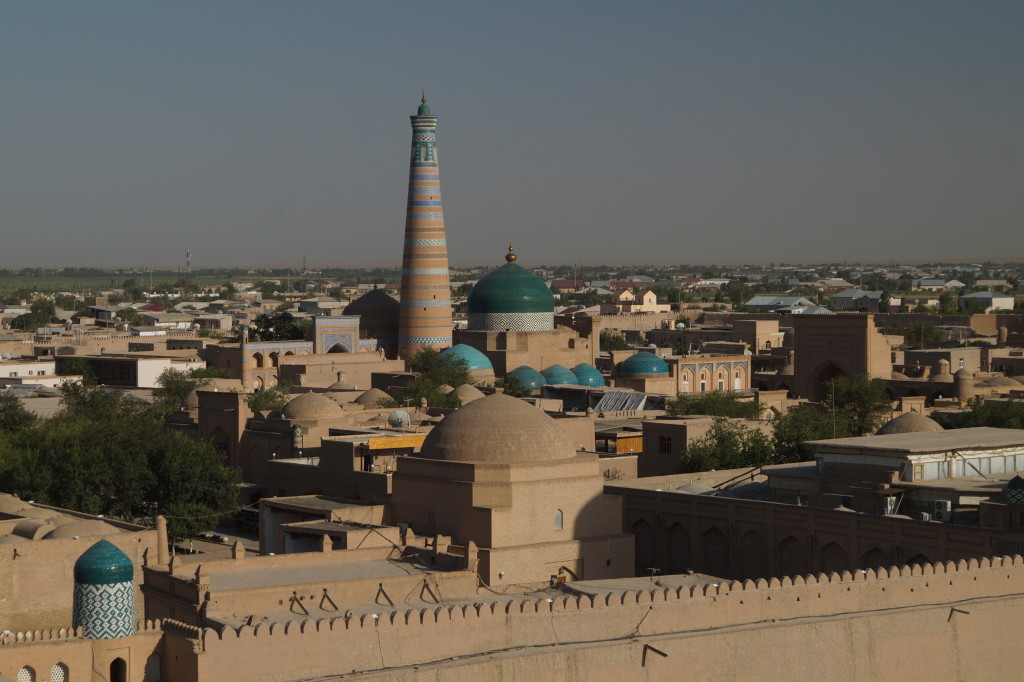
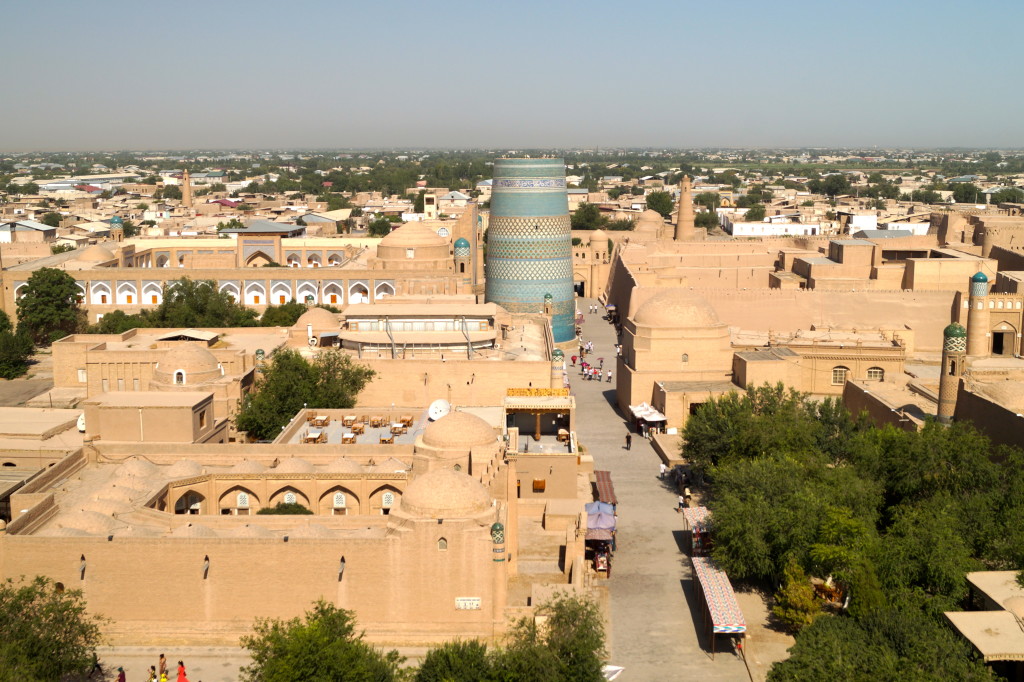
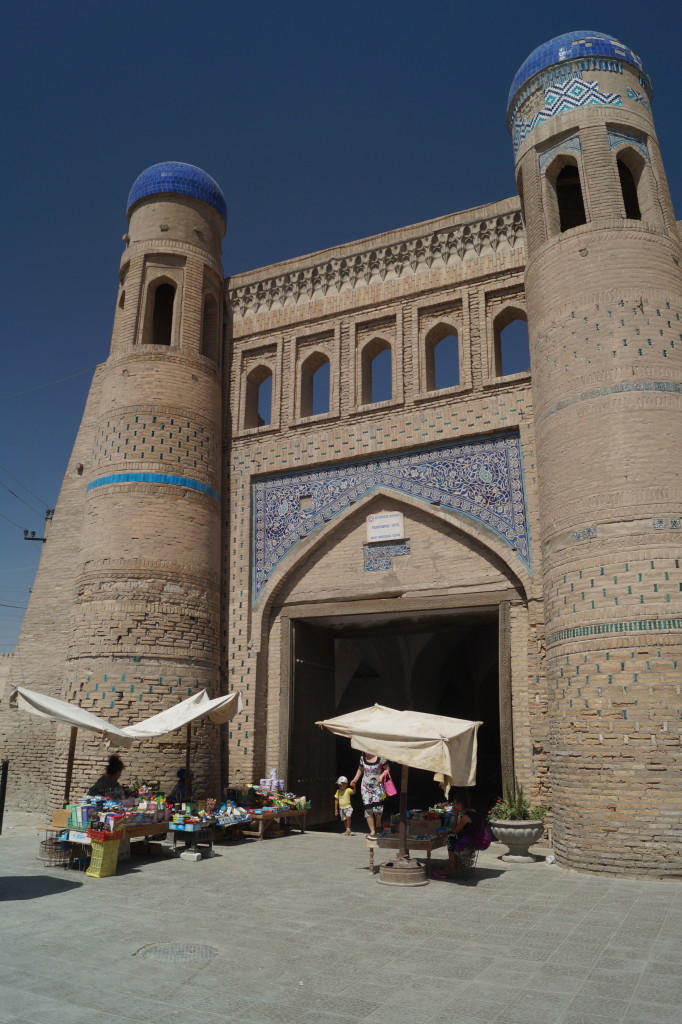
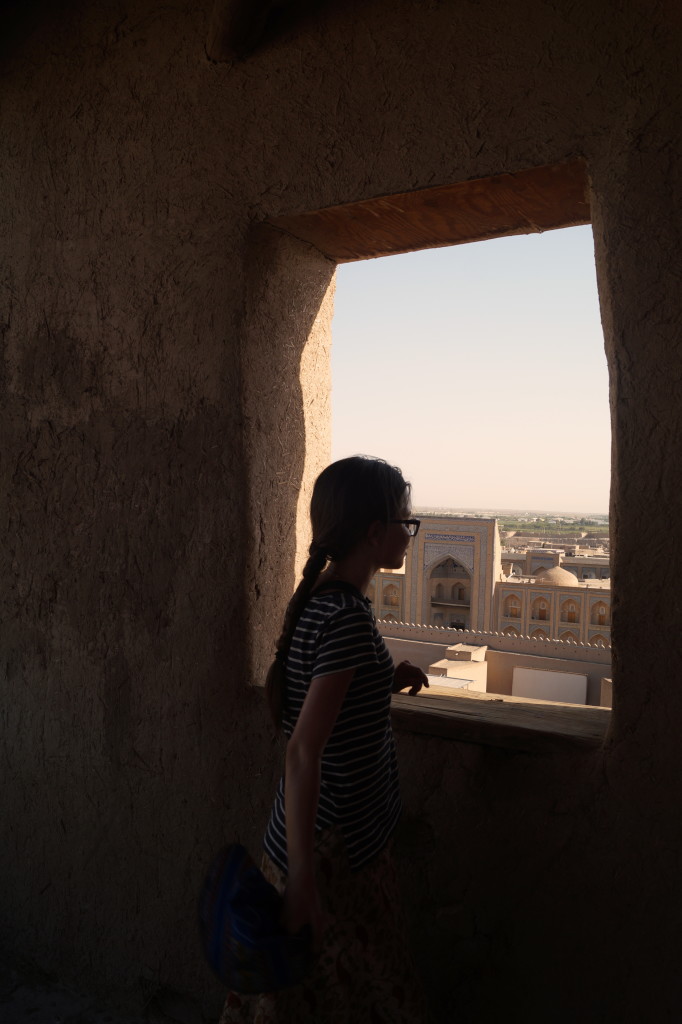
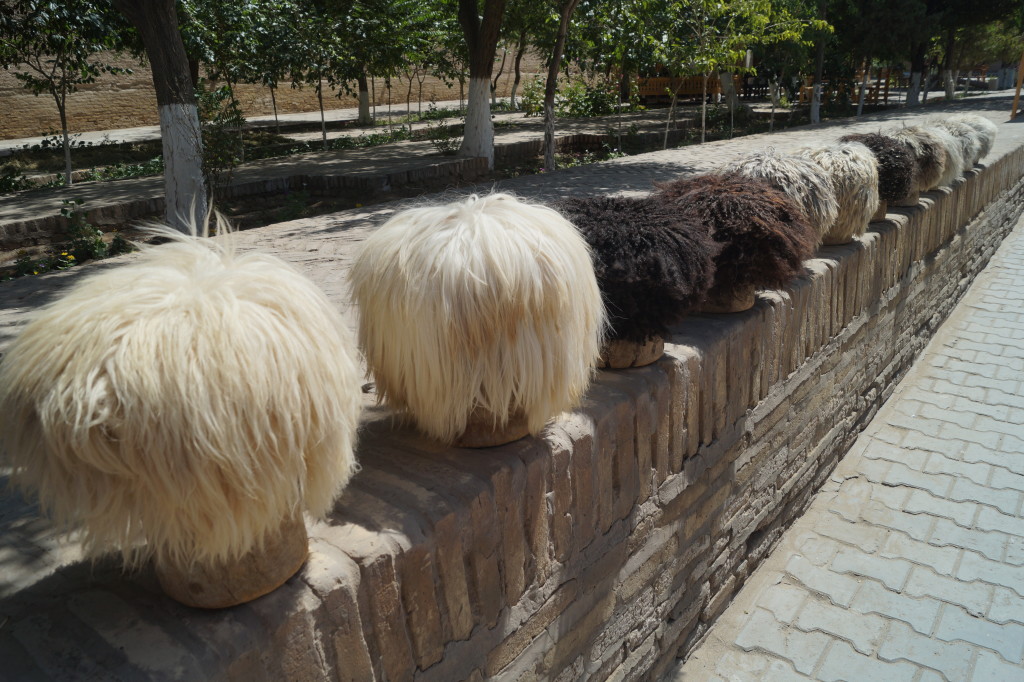 Our last city in Uzbekistan, Nukus, was a Soviet created city with none of the romance of its Silk Road counterparts. It did have an art gallery with an interesting history, its founder, Igor Savitsky, saved thousands of Soviet era avant-garde paintings that were supposed to be destroyed. It was our first stop on what will be a long drive across the desert, into Kazakstan and towards the Caspian Sea.
Our last city in Uzbekistan, Nukus, was a Soviet created city with none of the romance of its Silk Road counterparts. It did have an art gallery with an interesting history, its founder, Igor Savitsky, saved thousands of Soviet era avant-garde paintings that were supposed to be destroyed. It was our first stop on what will be a long drive across the desert, into Kazakstan and towards the Caspian Sea. 
































